for











k w h e r e J e s u s a n d O u r L a d y w a l k e d , p r a y a t t h e s a c r e d s h r i n e s o f t h e H o l y L a n d , a n d t o u r C a i r o , w i t h t h e P y r a m i d s , t h e H a n g i n g C h u r c h , a d i n n e r c r u i s e o n t h e N i l e , a n d m u c h m o r e . D a i l y l u n c h e s i n c l u d e d !


Led by Fr Chris Townsend
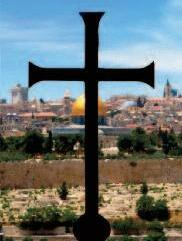

W a l k t h e a n c i e n t ‘ C a m i n o P r i m i t i v o ’ r o u t e f r o m L u g o t o S a n t i a g o d e C o m p o s t e l a ! Y o u c a n w a l k a t y o u r o w n p a c e , a n d a t t h e e n d b e c e r t i f i e d a s a C a m i n o p i l g r i m ! Y o u r l u g g a g e w i l l b e d e l i v e r e d t o y o u r h o t e l e v e r y d a y !








w w w. f o w l e r t o u r s . c o . z a / c a m i n o





Editor: Günther Simmermacher editor@scross
Business Manager: Pamela Davids admin@scross



Digital Editor: Claire Allen c allen@scross co za
Features Writer: Daluxolo Moloantoa daluxolo@scross co za
Advisory Editor: Michael Shackleton
ADVERTISING: advertising@scross co za
SUBSCRIPTIONS: subscriptions@scross co za
A n n uA l s u B s c r i p t i o n s: Print & Digital: R480 (SA); Digital only: R300; Print only: R480 (SA) Subscribe at www scross co za/subscribe
BOARD OF DIRECTORS: R Shields (chair), Bishop S Sipuka, Bishop S David OMI (alt), S Duval, E Jackson, B Jordan, C Mathieson, N Mpushe, Fr H O’Connor, R Perrier, D Shikwambana, G Stubbs
Become
Associate
www.scross.co.za/
campaign/
TH E B O O k O F E C C L E S I A S T E S advises: “Go, eat your food with gladness, and drink your wine with a joy ful heart, for God has already approved what you do” (9:7 8). So it ’s not surprising that Grazia Barletta’s monthly “Cooking with Saints” column is a firm favourite with many readers This month we feature Grazia on our cover, holding what could be described as an edible Advent wreath a salad, which is just the right kind of food for our summer climate
On the page adjacent to Grazia’s recipe and handy tips for the kitchen, we prepare for Advent, which this year begins on November 27, with a brief histor y of the Advent wreath and a guide to blessing one in your home. We shall have more on Advent in our special Christmas issue next month

In less than a year, the Synod on Synodality will be held in the Vatican By then the Church will have prepared for this momentous gathering for two years The important diocesan phase, in which the laity and clergy had their say, has been completed, and the summaries have been finalised and sent to Rome.
priest, potentially undoing years of building up such structures. Of course, new ideas and impulses can improve things, and some times old structures and processes need overhaul ing But this should not be imposed unilaterally by a priest who, after all, usu ally is a transient presence in the parish, appointed to serve a permanent commu nity. It would seem that new ways of managing parishes need to be developed.
help
from advertising@scross.co.za
at www.scross.co.za/advertising
Like many other regions, the South ern African Catholic Bishops’ Conference has released its report to the public It is candid and notes that the diocesan consultation has issued many challenges which our local Church must deal with Among the most urgent of these is that of the relationship between priests and parishioners
The report the most salient parts are reproduced with minimal editing in this issue mentions grievances about some priests “who make their own rules and push their own agendas”, among other things This obviously does not apply to all priests, most of whom do the best they can to ser ve the People of God However, there clearly are also in stances of abuses of power and even lapses in conduct among members of the clergy
Conversely, in some parishes, priests strug gle to find enough lay people to share in the responsibilities of running the parish.
Some parishioners report the experi ence of existing parish structures and processes being dismantled by a new
A nother prominent concern raised in the synodal consultation was that of formation This is a vague term which can be interpreted variously But at its heart, good formation means that Catholics know and understand their faith. Some Catholics take their own formation seriously, for example by join ing Bible study groups, taking courses, or reading Catholic books and publications Most Catholics, however, receive their formation once a week from homilies at Mass That simply cannot suffice, even when the preaching is good Poor forma tion leads to poor catechesis at home, and that can lead to a weakened faith and perhaps even a rejection of it within the family (which, of course, can also happen even despite good catechesis).
How do we, as the Church, bring for mation to the people? One very obvious way is by promoting Catholic media: books, magazines (such as the one you are reading right now), radio, podcasts, social media (though one has to be dis cerning in separating the good from the bad) It can be said that the widespread apathy of South African Catholics in mak ing use of the available means of social communications is a failure in formation itself As the Church builds on the insights gathered in the synodal process, addressing this failure should be an absolute priority And this must happen at every level of the Church: nationally through the bishops’ confer ence, in the dioceses and in the parishes
Thank you for reading The Southern Cross, and please tell your friends about your monthly Catholic magazine
The diocesan consultation for the Synod for Synodality revealed areas for improvement in the local Church
Funeral parlour director Tshepo Mofokeng on how he became an undertaker and on his active faith
Fr Stephen Ojapah speaks about his harrowing experience of being kidnapped in Nigeria in

The Pallottines arrived in SA in November 1922

Four of the greatest football World Cup stars in Qatar this month are Catholics
Did you know that there are patron saints for clowns, murderers, stupidity, oversleeping and spelunkers?
What our Advent wreath means, and how to bless yours at

Grazia Barletta offers a recipe for a Caprese Wreath, and gives handy tips for the kitchen
Günther Simmermacher on seeing the Oberammergau Passion Play and exploring Catholic Bavaria

The

Synod: The Church
faithful want

The Jewish people as a whole cannot be blamed for the crucifixion of Christ, one of five new decrees proclaimed by the Second Vatican Council declares Referring also to the Christian Muslim wars of the Crusades, the decree orders a new course in Catholic relations with other faiths Another decree, at 10 000 words the longest yet, endorses a synod of bishops to advise the pope and urges a restructuring, possibly the most comprehensive ever, to make it more representative of the Church The other three decrees deal with Catholic education, seminaries, and religious The Second Vatican Council, which began in October 1962, will close on December 8
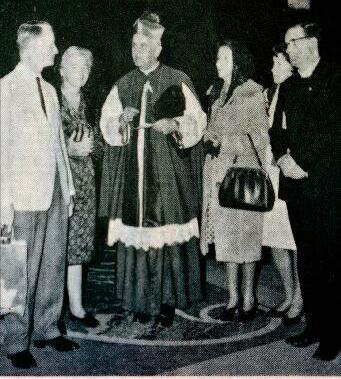

Dr JJP Visser told the synod of the Dutch Reformed Church that the Catholic Church has become so dynamic that there is a danger it could convince Protestants “Roman Catholics argue on so high a plane that the war cries and scare stories of which our church is so fond will not help,” Dr Visser said
In his editorial, Fr Louis Stubbs writes that majority rule, an option counted during the British Rhodesian talks, would not mean that the majority would actually rule the countr y “Majorities in any society only rule on election day, and that assuming that elections are free and fair For the rest of the time, the conduct of affairs is carried on by a minority, an aristocracy, that of the office holders ”


• The whites only government of Southern Rhodesia issues a unilateral declaration of independence from Britain, with Ian Smith declared prime minister Only South Africa and, until 1974, Portugal recognise Rhodesia’s statehood
• Roger Allen LaPorte, 22, a Catholic Worker Movement member, dies after setting himself on fire in New York City in protest against the Vietnam War. He’s the second US protester this month to die after self immolation.
• Harvard botany professor Elso Barghoorn announces the discovery of the earliest evidence of life on Earth, with the finding of fossil evidence from three billion years ago in South Africa, near Barberton, and in Swaziland.

• Rhodes University in Grahamstown installs a computer, the first university in South Africa to do so.
n e w A n g l i a m o d e l R i g h t : B i s h o p E r n e s t G r e e n o f P o r t E l i z a b e t h b e f o r e o n e o f t h e V a t i c a n I I m o r n i n g M a s s e s i n S t P e t e r ’ s b a s i l i c a , w h i c h p r e c e d e d t h e c o u n c i l ’ s d a i l y d e l i b e r a t i o n s T o t h e r i g h t o f h i m a r e E i l e e n D o w l i n g a n d h e r d a u g h t e r P a t r i c i a o f P r e t o r i a ( m o t h e r a n d s i s t e r o f t h e f u t u r e B i s h o p K e v i n D o w l i n g ) , a c o u p l e f r o m D u b l i n , a n d F r H a y n e o f L o n d o n

Q . O u r p a r i s h p r i e s t o c c a s i o n a l l y o f f e r s t h e S u n d a y M a s s f o r t h e r e p o s e o f s o m e o n e ’ s s o u l W h e n t h i s h a p p e n s , h e r e p l a c e s t h e C o l l e c t , t h e P r a y e r O v e r t h e G i f t s , t h e P r a y e r a f t e r C o m m u n i o n a n d , o c c a s i o n a l l y , e v e n t h e P r e f a c e , o f t h e S u n d a y w i t h t h o s e f r o m a M a s s f o r t h e D e a d . H e h a s d o n e t h i s i n O r d i n a r y T i m e a n d a f e w t i m e s d u r i n g L e n t W h e n h e d o e s t h i s , i s h e c e l e b r a t i n g t h e S u n d a y M a s s o r a M a s s f o r t h e D e a d , a n d i f h e h a s e f f e c t i v e l y t u r n e d t h e S u n d a y M a s s i n t o a M a s s f o r t h e D e a d , i s m y S u n d a y o b l i g a t i o n f u l f i l l e d ?
AS YOU SURMISE, YOUR PARISH priest has confused two things:
[i] saying a Mass for the Dead, and [ii] offering a Mass for the repose of a soul Let’s unravel the two

At the front of the Roman Missal, we have all the liturgies for the Cycle of Seasons and the Cycle of Saints. These are the regular Masses that take precedence, and you would expect every Sunday celebration to come from here
At the back of the Missal, we have Votive Masses and the Masses for the Dead None of these may displace the proper liturgy on Sundays and holy days When we celebrate a Mass for the Dead, we change the colour of the vestments and have special prayers, in cluding the Preface If your priest paid attention to the ordo a list of offices and feasts for each day of the year he would see on which days Masses for the Dead are not permitted
It is permitted, however, to cele brate a Sunday Mass for the intention of a departed loved one The Mass intention may be announced before

Q I ’ m c o n f u s e d M y p a r i s h p r i e s t s a y s t h a t t h e r e m a y b e n o e u l o g i e s a t a f u n e r a l M a s s , b u t I ’ v e b e e n t o f u n e r a l s i n C a t h o l i c c h u r c h e s w h e r e a p r i e s t a l l o w e d e u l o g i e s . A r e e u l o g i e s a l l o w e d , o r a r e t h e y n o t ?
YO U R P R I E S T M I G H T H A V E b e e n r e f e r r i n g t o t h e O r d e r o f C h r i s t i a n F u n e r a l s , w h i c h i s t h e C h u r c h ’ s g u i d e b o o k f o r s u c h c e l e b r a t i o n s . T h e g u i d e b o o k d o e s s a y t h a t “ t h e r e i s n e v e r t o b e a e u l o g y ” ( N o 2 7 ) B u t t h a t s e c t i o n i s m e a n t t o o f f e r g u i d a n c e t o t h e p r i e s t c e l e b r a n t w i t h r e g a r d t o t h e h o m i l y
I t r e m i n d s t h e c e l e b r a n t t h a t a C a t h o l i c f u n e r a l i s n o t t o c o n s i s t i n t h e g l o r i f i c a t i o n o f t h e d e c e a s e d ( e v e n l e s s , t h e “ c a n o n i s a t i o n ” ) T h e f u n e r a l M a s s i n s t e a d i s m e a n t t o u s e t h e s c r i p t u r a l r e a d i n g s t o




h i g h l i g h t t h e r e d e m p t i v e p o w e r o f C h r i s t ’ s r e s u r r e c t i o n , t o p r a y f o r t h e d e c e a s e d , a n d t o c o m f o r t t h e m o u r n e r s b y r e m i n d i n g t h e m t h a t e v e n t u a l r e u n i o n a w a i t s i n h e a v e n .
T h e s a m e O r d e r o f C h r i s t i a n F u n e r a l s s a y s i n a l a t e r s e c t i o n t h a t “ a m e m b e r o r a f r i e n d o f t h e f a m i l y m a y s p e a k i n r e m e m b r a n c e o f t h e d e c e a s e d b e f o r e t h e f i n a l c o m m e n d a t i o n b e g i n s ” ( N o 1 7 0 ) S o m e d i o c e s e s m a y h a v e t h e i r o w n r e g u l a t i o n s , l i m i t i n g t h e l e n g t h o f t h o s e r e m a r k s T h r e e o r f o u r m i n u t e s w o u l d b e t y p i c a l R e c e n t l y , I h a v e n o t i c e d t h a t s o m e p a r i s h e s m o v e t h e s e f a m i l y r e m a r k s u p t o t h e b e g i n n i n g o f t h e l i t u r g y p e r h a p s f e e l i n g t h a t i f t h e s p e a k e r s t r a y s f r o m t h e p u r p o s e o f t h e M a s s , t h e c e l e b r a n t c a n “ r e s c u e ” t h e s i t u a t i o n b y
Mass, and the name of the deceased may be included in the Prayers of the Faithful The prayers of the Mass, however, remain those of the Sunday or feast day and, if using Eucharistic Prayers II or III, we do not add in the extra paragraph for the deceased as we would at a funeral.
Should a priest open the Missal on the wrong page, or put on the wrong vestments, we call his actions “illicit”, but such matters do not prevent the faithful from fulfilling their Sunday ob ligation or from receiving God’s grace

Nevertheless, we should insist that the clergy understand what they are supposed to do so as to preside more effectively over our common prayer (Fr Thomas Plastow SJ)
r e t u r n i n g t o t h e t h e m e s o f r e s u r r e c t i o n a n d r e u n i o n I n t h e e n d , t h o u g h , m u c h o f t h i s d o e s d e p e n d o n t h e d i s c r e t i o n o f t h e l o c a l p r i e s t , w h o I h o p e w o u l d t a k e i n t o a c c o u n t t h e f e e l i n g s a n d d e s i r e s o f t h e g r i e v i n g f a m i l y
(Fr Kenneth Doyle)Q In a documentary I watched on YouTube, it was alleged that Pope Pius XII was complicit in the Holocaust by not speaking out against it Is there any truth to that?
Pius XII may still need further study, but it is demonstrably untrue that the pope was indifferent to the persecution of Jews, never mind being some kind of Nazi stooge The whiff of the latter still clings to the memory of Pope Pius thanks to a polemical book from 1999 by John Cornwell titled Hitler’s Pope, which sometimes still serves as a convenient stick with which to beat the Catholic Church. I suspect the video you watched was of that nature

A recently published book by historian David Kertzer, The Pope at War, draws from research in the Vati can Archives and offers a more sober but also unflattering analysis of the pope’s war time record Kertzer is critical of the Vatican and the pontiff, but finds that Pius was neither anti Semitic nor “Hitler’s pope” Rather, he writes, Pius was concerned about stay ing neutral and being surrounded by Mussolini’s fascist regime, fear of reprisals was a reasonable concern.
Another new book based on research in the Vatican Archives, The Pope and the Holocaust by Michael Hesemann, even considers Pius a defender of Jews

It is true that Pope Pius issued no explicit condemnation which named the perpetrators or the victims of the Holocaust, though he did speak out once In his 1942 Christmas broadcast,


he said: “Humanity owes this vow [of working towards a just society] to those hundreds of thousands who, without any fault on their part, some times only because of their nationality or race, have been consigned to death or to a slow decline ” Everybody knew what he meant. Reinhard Heydrich, a leading Nazi, rebutted that Pius “makes himself the mouthpiece of the Jewish war criminals”.
For Pope Pius’ defenders, his reluc tance to speak out more trenchantly was a prudent decision, intended to prevent further tragic Nazi reprisals for Church criticism, such as the round up of Jews and non Aryan Catholics in the Netherlands after the region’s bishops condemned Nazi persecutions For his critics, these concerns at best showed moral cowardice and at worst some sort of complicity
Pope Pius was a diplomat by train ing, and diplomats don’t like unpre dictability Pius believed for a long time that the Nazis might win the war and he feared that they then would persecute those who opposed them Pius also adopted a policy of neutrality in the hope that he might be called to broker peace negotiations
Whichever conclusion one may arrive at, the notion that Pius XII was indifferent to the Holocaust is not sustainable Pope Pius is said to have approved some Catholic initiatives in saving Jews, especially in Italy as well as through papal nunciatures such as those in Budapest and Istanbul Indeed, the Church’s ostensible neutrality might have been a key to these efforts
In Rome, around 5 200 of the city’s 6 730 Jews escaped the Nazis’ round up on October 16, 1943, most of them because they were given refuge in Church institutions, though Kertzer’s research found that some officials were more interested in saving Jews who had converted to Catholicism


t is academic whether or not Pius XII’s restraint in speaking out was a prudent decision or a grave error We cannot know whether condemnations would have tempered the Nazis’ genocidal policy, especially when such censure came from a man whom that regime considered an enemy. After they occupied Rome in 1943, the Nazis reportedly debated whether to imprison or to assassinate the pope
Historians may argue to what extent Pope Pius was involved in those rescue operations, and others like them throughout Italy, but it is incon ceivable that it would have been possible without at least papal knowl edge and, indeed, his approval
Post war Jewish leaders such as Golda Meir, Albert Einstein and Roman Chief Rabbi Israele Anton Zolli needed no such proof: they hailed Pope Pius as a “righteous gentile” for his lifesaving efforts on behalf of Italian Jews
(Günther Simmermacher)THE CATHOLIC FAITHFUL IN Southern Africa are looking for a more “listening, open and consultative” leadership in the Church, according to the summar y re leased by the Southern African Catholic Bishops’ Conference on the discussions held in preparation for next year’s Synod on Synodality in the Vatican
Pope Francis’ approach of consult ing the faithful, and even those who are not practising the Catholic faith, is un precedented It responds directly to that desire for a more “listening, open and consultative” leadership

The SACBC’s 10 page “Bishops’ Conference Synodal Synthesis” has been for warded to the Vatican, alongside sim ilar documents by all other bishops’ con ferences Along with other consultations, these will form the basis of discussion at the Synod on Synodality, which will be held in October 2023 These are the most pressing points in the document



There is an appreciation of Church leadership and what bishops do within



This year, dioceses throughout the world entered into a process of consultation in preparation for next year ’s Synod on Synodality. Here are the results of discussions in the Southern African conference region.
the Church and in the wider society. However, for some there was a desire for a change in leadership style, from the tendency of being autocratic and bureaucratic to being more listening, open and consultative. This was a desire from both lay people and clergy



Some criticism of leadership included a lack of transparency about sexual and financial crises, lacking leadership in terms of international and national
velopment of greater priestly fraternity is something that needs attention, with certain expressions of difficulty in belonging and building unity being made There is a desire for pastoral care and outreach between priests
events, the way the clergy abuse crisis was handled, and a poorly projected public image of the Church The general feeling was that there was the desire to see more visibility and leadership

Priests repeatedly raised issues such as relationships with their bishops, leadership styles, pastoral care, commu nication from chanceries, and the lack of implementation of decisions The de

From the side of the laity, there was a great appreciation for the work of priests However, concerns were raised about incidences of financial abuse, low moral standards, lack of liturgical and preaching preparation, apparent poor education and lack of basic pastoral skills, variety of attitudes taken towards women, youth, the LGBTQIA+ commu nity, difficulty relating to other men, lay involvement, priests not able to minister in communities they are assigned to, and poor example and behaviour These have an impact on vocations and the happiness of the laity The laity’s view was that there also needs to be a move away from clericalism and clergy centred communities to greater involvement of all in the life and running of the Church
In dioceses where the diaconate has been revived, there is deep respect for the sacrifices that permanent deacons



There needs to be a move away from clericalism to greater involvement of all
make, as married men with families There is a call for the acceptance of women to the diaconate and the ordination of married deacons to the priesthood Ongoing formation pro grammes for deacons was requested



The contribution of consecrated people was done separately and sent directly to the Dicastery for Institutes of Consecrated Life and Societies of Apos tolic Life in Rome The report was shared with the SACBC’s secretariat Some reli gious women also participated in the diocesan process. What came through in the diocesan responses was a concern regarding the decline in vocations, the lack of involvement of religious especially women in diocesan structures and the life of the diocese There was also a call from religious women to be taken more seri ously and acknowledged for their contri bution to the life of the Church, and not to be treated like second class members
participation However, there is an impression that these structures are not properly utilised to allow for full participation It is perceived that either the priest, certain families or individuals dominate these structures, keeping others out Small Christian Communities, pastoral districts, parish councils, finance councils, and diocesan pastoral councils all provide opportunities for involve ment. There are seats at the table it is a matter of getting people to the table
The kind of participation that is desired is one where the gifts of all members are used, for example by opening preaching to lay people (includ ing women), widening involvement in ministries and responsibility, and so on There is a request that lay ministries be developed but sufficient space must be given for the exercise of these ministries It is also important that people may see that they can participate
for this There is the constant request for better catechesis and ongoing faith formation for all.
The parish has an important role to play in the evangelising mission of the Church The parish should not just be a place for Mass, with the doors closed the rest of the time It needs to reach out to the community and have a mission of welcome to all, providing support to the wider community Mission is sometimes hampered by lack of funds, but fundraising can be used as part of the outreach.
The challenge of communion is the building of more inclusive and welcom ing communities open to people on the margins, the divorced and remarried, LGBTIQIA+, street people, the deaf and disabled, and all those who do not currently feel welcomed in the Church In many places there is the desire for an experience of community but how it is to happen remains a challenge.
While acknowledging a core of com mitted Catholics, many of the responses indicated a disappointment in the num ber of people actively involved in the life of the Church community Many good ideas for local revitalisation were shared, and these need to be taken up at the appropriate levels in parishes and dioce ses The average Catholic wants a good, holy priest pastoring and ministering to them and an alive and active community.
The Church has the necessar y structures to encourage and allow for
There is a need for faith formation across the different sectors of the Church

The primary place for receiving faith for mation is through preaching, but if homilies are not good, where is the faith imparted? There is the need for parents to be involved in the formation of their children This is an important point to remember as many of the responses indi cated the Church’s primary responsibility

Issues that are seen to be hamper ing the mission of the Church included a lack of ongoing formation from priest to lay minister, priest shortages, priests who make their own rules and push their own agendas, moral decay among the clergy, lack of respect and participa tion, inadequate ministr y to families, failure to use resources properly, issues around baptism of children of unmarried mothers, divorced people and so on There is a desire for practical action which makes the spoken word of Jesus Christ real.
The ministry around Justice & Peace and environmental issues did not receive widespread comment as many of the reflections focused strongly on the relationships within the parish or the diocese This is possibly an area that needs reflection as the context of the Southern African Church remains fertile ground for this ministry. The issue of reconciliation in a region where it is most needed also received scant mention Just because these were not focused on does not mean that they are unimportant and do not need to be addressed. However, these issues are reflected in the desire for the Church to play a more visible role in the society than it has in the past
A great deal of comment was offered on the state of the youth and their presence in the Church It was noted that the youth are not just the future of the Church but that they are also the present of the Church The synod process noted that young people’s involvement ranged from active participation to near total absence. There is a general concern that many young people leave the Church after confirmation, if they even get as far as that. Some of the reasons given were hostility towards the youth, intergenera tional conflict, role of parents, teenage pregnancy, the Church’s moral teach ings, temptations in the wider world, lifestyle choices, and lack of attractive ness of the Church.
The relationship between young people and the Church is something that needs reflection and development in the areas of catechetical programmes, good preaching, creation of an open environment, good liturgy, and a deeper spirituality
Many of the responses included practical suggestions for strengthening marriage and family life in the society There were requests that the Church reconsider matters such as divorce, remarriage, contraception, and Canon Law regarding marriage
Traditional marriage as an institution is still considered important and desirable. However, there is a strong need to look beyond the ideal of heterosexual marriage to other forms of being family single parent, LGBTQIA+, multigenerational and blended families, and adoption There needs to be more open space for discus sion around issues affecting family and marriage without being shut down by the law or morals of the Church People who suffer the breakdown of their marriage appear to be stigmatised
More emphasis needs to be placed on the formation of the family as the domestic church This should become the starting point for what we see as a uni versal call to holiness, and the Church’s role is to support this spiritual growth through pastoral programmes that build up families as schools for holiness

Ecumenism is seen to be of increas ing importance Many responses pointed to a lack of denominational concern by the Catholic Church, raising a desire for an open Eucharistic practice (especially when there is a coming together of various denominations), preaching to be open to lay people as in other Churches, confusion in liturgical celebrations, and the idea that all denominations are equal The ecumenical contacts are generally around weddings, funerals, cultural events, and family events
change in style and formation at all levels for new ways to emerge.

The next step in implementation is to put into action at various levels of the Church community the practical sugges tions of this process, so that people feel listened to and their participation is shown to be valued The feeling that “we have seen all this before, what’s the point and why bother” needs to be guarded against by working towards real outcomes
The whole issue of formation and training of adults, catechists, liturgy groups, parish pastoral and finance committees, and Small Christian Communities needs to be prioritised
This is an ongoing task
For some, religious ecumenism is the joint witness, where the Church acknowl edges and cooperates with other Christian denominations. Prayer is seen as uniting Christians who come together to pray for the needs of the Church and world
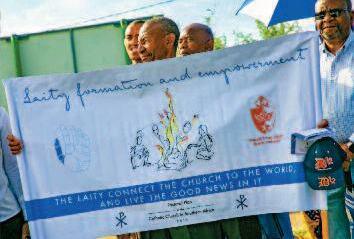
Interreligious dialogue was not a strong feature in the responses; when it was mentioned, it was in the context of respect and working together There is also a confusion between ecumenism and interreligious dialogue
Another area that requires atten tion is the issue of youth and their relationship to the Church A great deal has been written about this rela tionship, but there is still a disconnect between young people and the Church.
The SACBC document stresses that the process of the Synod must not just be measured by the number of people who did or did not participate, the an swers given, whether agreed with or not, but by the quality of the listening, dialogue and desire to relate in new ways In a process like this it is easy to get caught up in responses that call for change, and to forget that real change begins in the hearts of individuals and then flows out
Living the Synod means becoming a community on all levels: a spirituality of journeying together, listening to one another, building strong relationships, unity, shared values, common under standing, ser ving others, mutual respect, mutual recognition, shared responsibil ity, transparency, honesty, and humility To achieve this, there needs to be a
This synodal process has been invaluable in helping reflection on the implementation of the Pastoral Plan, which was launched in Januar y 2020 These two initiatives working together will help shape the pastoral priorities of the Southern African Church moving for ward The Pastoral Plan as well as the questions raised by the synodal present a basis for further listening and dialogue The questions and discussions are not an end in themselves but provide a frame work for working in the future
The Diocesan Synod Reports need to be studied by the relevant depart ments of the SACBC as well as by diocesan structures On one level these structures need to look at the practical suggestions and ideas and see to their implementation as far as possible A similar process can be undertaken on a national level
This will give people the confidence that there indeed is action. The more difficult task is to change the culture in the Church, where necessar y, to create an atmosphere and a practice that includes more listening and dialogue in the search for greater communion, participation, and mission in the Church
There is the constant request for better catechesis and ongoing faith formation for allT h e d e l i b e r a t i o n s f o r t h e S y n o d o n S y n o d a l i t y l o o k e d a t i s s u e s s u c h a s t h e y o u t h , e c u m e n i s m a n d f o r m a t i o n A l l o f t h e s e d i s c u s s i o n s w i l l i n f o r m t h e i m p l e m e n t a t i o n o f t h e P a s t o r a l P l a n , w h i c h w a s l a u n c h e d i n J a n u a r y 2 0 2 0 . Photos: Sisanda Nxele Denis Hurley Centre Sheldon Reddiar
ALL SOULS’ DAY IS A DAY OF prayer and remembrance for the faithful departed, which is obser ved by Catholics and other Christian denominations annually in November. For Tshepo Mofokeng, 33, the month of November is a time in which he renews his commitment to his mission, in living his Catholic faith and as the managing director of a funeral parlour based in Klerksdorp.
The last born of six children, Tshepo spent the first years of his life under his grandparents’ watchful eye in Thabong township, Welkom He was baptised at Mofumahadi wa Rosar y church in Thabong. In 1996, he moved to Klerksdorp to live with his parents.
At 16, Tshepo became an altar server at Maria Mmamohau church in Klerks dorp, and later joined the parish’s Chiro Youth Movement, where he discovered his love for music. For some time as a youth, he lived fulltime at the church because it had no resident parish priest, until the appointment of Fr Anthony Ngwu MSP
After high school Tshepo earned an IT and computer science qualification. In the absence of job offers, he opened his first business, an Internet café, in Klerksdorp “I assisted people by typing CVs for them and fixing their comput ers,” he told The Souther n Cross. How ever, cable theft in Klerksdorp doomed his business
In January 2014 a new opportunity presented itself A local businessman Tefo Lekitlane, offered Tshepo a chance to work with him at his newly opened funeral parlour business. That business also faced insurmountable challenges leading to its quick demise But Tshepo took the lessons he learned from the failures of both business ventures, and by August that year opened his own fu neral parlour business, which he named Remmogo Retlotlegile Burials
“I see funeral undertaking as a partic ular calling, because initially I had no in terest in working in the funeral services industry,” he said. Part of that vocation is to offer dignified but affordable funeral

packages which won’t force the bereaved to go into debt, something that addresses a concern expressed by several Catholic Church leaders in South Africa. These packages are tailored to offer funeral poli cies, funeral services, cremation, exhuma tion of mortal remains, repatriation services and tombstones
In his spare time, Tshepo combines his faith with his love of music As a youth in 2007, he joined his parish’s St Cecilia Sodality, so that he could use his love of music to express his appreciation of being a Catholic. Two years later, at the age of 20, he became the youngest ever musical director/choir conductor at his parish.
In 2014 he became a diocesan mu sical director of the St Cecilia Sodality in the diocese of Klerksdorp In that capac ity he conducted the musical affairs of the diocesan mass choir at the episcopal ordination of Klerksdorp’s Bishop Victor Phalana in 2015

In 2017, Tshepo believed that God was calling him to serve him in another vocation “I strongly believed that God was redirecting my life to serve him as an ordained priest I put my business af fairs on hold, and with the blessing of

Bishop Phalana I embarked upon my journey to becoming a priest at the St Francis Xavier Orientation Seminary in Cape Town ” In the event, he didn’t pur sue his seminary studies further
So his undertakers’ business remains his vocation It is still a learning process Tshepo recalls one such instance “On January 16 last year I received a call from Bishop Phalana. He was requesting my services for the funeral of the late Fr Tom Maretlane, who had passed away while on holiday in his home country of Lesotho Fr Tom had expressed his wish to be buried in the diocese of Klerksdorp So I was tasked with the duty of repatri ating his earthly remains from Lesotho to South Africa It was our company’s first time handling such a task, and we did it to everybody’s satisfaction ”
This was a prelude to an arrange ment going in the reverse direction in July, when the remains of Fr Adrian Led imo had to be relocated from Klerks dorp, where the popular priest had served, to his homecountry of Lesotho

The relationship between Remmogo Reatlegile Burials and the Church is not always about the provision of funeral services by the company It’s also about giving back and making a contribution to the Church’s mission in various ways, Tshepo said “We assist with funeral ser vices for indigent families who can not afford to pay for the services.”
His company is also involved in reaching out to the Church’s social re sponsibility projects through sponsor ships “For Youth Day this year, for example, we co sponsored a youth undraising event in our diocese ” Tshepo hopes the latter will help make “a meaningful impact on the youth in our Church”.
Tshepo has wise counsel for young people “I’m convinced that true moti vation comes from within It never works until one puts in the work oneself, and also prays I live by the motto: ‘Yes terday was hard. Tomorrow may be harder. The day after, you’ll rejoice and give thanks to Our Lord Jesus Christ ’”
AFTER AN EXHAUSTING DAY of parish work, Fr Stephen Ojapah had fallen fast asleep late on May 25 when sud denly two men armed with rifles ordered him to get out of bed and follow them
For years the priest of the north ern Nigerian diocese of Sokoto in Gidan Maikambo in the Kafur County of Katsina State had prayed for clergy slain by terrorists and for those who were kidnapped and tortured Now he was the one who needed prayers.
Fr Ojapah, 38, was kidnapped along with his assistant priest, Fr Oliver Oparah, as well as Hassan Fa reed Hassan and his sister and mother, who had the bad luck of staying overnight at the rectory compound supposedly a safe place to stay while they were on a multi day journey
Fr Ojapah was dressed only in a shirt and pyjama shorts; the kidnap pers didn’t give him time to put on shoes He wouldn’t change his clothes again for 33 days “During the first three hours, I was in trauma and could hardly stand,” Fr Ojapah recalled in an inter view with the Catholic News Agency. “They beat me and cursed [at] me, but I kept fainting In panic, I requested that the abductors give me some of the drugs they were popping, but the drugs made me drowsy ”
His abduction was not a random act, he learned. “They knew exactly what they were doing, and it became clear they weren’t doing it just for the money,” the priest said “The leader of the abductors told me they had studied our location and planned the attack on our compound just as most of us were asleep ”
Fr Ojapah’s ordeal began with a six hour march through the forest without shoes “Some of us had shoes, and they would share them with me for part of the march, but by the time
the party stopped at daybreak, my feet were cut and bleeding ”
The abductors marched the group for 25km in a southwesterly route the first night, then rested for the daylight hours of May 26 in a brush shelter. The group then marched 12 hours on May 27 before riding for three hours on motorbikes into a bandit strong hold near the Kwiambana Game
Reser ve, which straddles the border of Niger and Kaduna states They walked altogether as many as 70km and rode bikes for about 50km, Fr Ojapah esti mated
“We prayed the rosar y silently during the march,” Fr Ojapah said He also recited words from a psalm which he knew from memor y: “Whoever dwells in the shelter of the Most High will rest in the shadow of the Almighty I will say of the LORD, ‘He is my refuge and my for tress, my God, in whom I tr ust ’ Surely he will save you
from the fowler’s snare and from the deadly pestilence ” The priest recalled:
“The words calmed us down, making us feel like we were covered from danger,” he said
The terrain along the way is forest savannah and dotted with small towns and villages of farmers and herders
The region is controlled by rival ban dit gangs and insurgents who identify with the Islamic terrorist group Boko Haram or a splinter faction called Ansaru Both the insurgents and the bandit gangs use kidnapping for ran som as a continuous revenue stream
Priests and clergy of other faiths increasingly have become targets of kidnapping gangs, which has made Nigeria the most dangerous countr y in the world for Christians, according to Open Doors UK As many as 16 Chris tians are killed for their faith ever y

day in Nigeria, the humanitarian nongovernmental organisation has reported
During their stay in the bandit encampment in Birnin Gwari, Fr Ojapah’s group of hostages received little to eat except rice, beans, palm oil, and water The five captives were joined by other victims, including a Protestant pastor and three members of his con gregation
The group of abductees sat for hours in silence and listened to the sounds of the forest, which is home to monkeys, warthogs, wolves, a pro fusion of birds, scorpions, and deadly vipers When clouds opened and poured down rain, the bandits moved to the shade of trees with dense fo liage, but the abductees were chained to their hut, which leaked cold rain on them for hours, Fr Ojapah said.
During their trek through the for est, they had to drink from any avail able stream or puddle At night they shivered through temperatures in the mid teens “We all got colds,” he said “ T h e b a n d i t l e a d e r t o l d m e t h e i r g r o u p w a s A n s a r u , ” t h e j i h a d i s t g r o u p t h a t s p l i t f r o m B o k o H a r a m i n 2 0 1 2 ,
F r O j a p a h s a i d A f t e r c o n t a c t i n g a p r i e s t i n S o k o t o u s i n g F r O j a p a h ’s c e l l p h o n e , t h e b a n d i t s s e t t l e d d o w n f o r a l o n g w a i t u n t i l r a n s o m c o u l d b e o b t a i n e d T h e b a n d i t s p a s s e d t h e i r d a y s s m o k i n g m a r i j u a n a a n d t a k i n g d r u g s , F r O j a p a h s a i d , w h e r e a s t h e
r e l i g i o u s m i s s i o n A f t e r a v i l l a g e h a s b e e n b u r n e d a n d r a i d e d t h r e e t i m e s , t h e r e s i d e n t s j u s t d o n ’t w a n t t o r e t u r n t o i t , a n d t h e j i h a d i s t M u s l i m s s e e t h a t a s G o d ’s b l e s s i n g u p o n t h e i r c r i m e s , ” F r O j a p a h s a i d
p r i e s t s r e c i t e d S c r i p t u r e a n d p r a y e d i n s o f t v o i c e s “ D o y o u s m o k e w e e d ? ” t h e b a n d i t l e a d e r a s k e d , t e l l i n g h i m : “ I c a n ’t e v e n e a t b r e a k f a s t w i t h o u t t a k i n g d r u g s f i r s t ”
T h e b a n d i t g a n g s r e p o r t e d l y v i c t i m i s e M u s l i m s a n d C h r i s t i a n s a l i k e , b u t F r O j a p a h s a i d t h e g a n g l e a d e r ’s o w n w o r d s s h o w o t h e r w i s e “ T h e r e w a s a M u s l i m c a p t i v e a m o n g u s n a m e d A l h a j i N u r a f r o m K a n o B u t h e w a s f i n a l l y l e t g o w i t h o u t a n y r a n s o m ” T h e p r i e s t t h o u g h t t h a t t h e m a n c o u l d h a v e b e e n a s p y. “ T h e b a n d i t s t o l d u s t h a t t h e y s e e t h e e x t e r m i n a t i o n o f C h r i s t i a n s a s t h e i r
Be part of our apostolic work by joining our Associates campaign. sign up for a minimum contribution of r100 per month. tell us how you would like your contribution to be spent by choosing from these three membership options:


• Yo u a re we l co m e to s e l e c t m o re t h a n o n e o pt i o n
• Re c e i ve a f re e d i g i ta l o r p r i nt s u bs c r i pt i o n i f yo u co nt r i b u te R 2 0 0 o r m o re p e r m o nt h
• A s a n A s s o c i ate , h o l y M a s s w i l l b e c e l e b rate d fo r yo u r i nte nt i o n s t w i c e a ye a r
• A s s o c i ate s w i l l re c e i ve re g u l a r u p d ate s o n t h e ca m p a i g n
• s i g n u p o n l i n e a n d s e l e c t R 1 2 0 0 , R 2 4 0 0 , R 3 0 0 0 o r R 5 0 0 0 a n n u a l co nt r i b u t i o n o r a ny a m o u nt v i a E F T. s i g n u p o n l i n e w w w d i g i t a l s c r o s s c o z a /a s s o c i a t e s c a m p a i g n o r e m a i l a d m i n @ s c r o s s c o z a f o
d
“ A f t e r 3 0 d a y s , o u r c a p t o r s s a i d a l l b u t t w o o f u s w e r e c o m i n g h o m e , ” F r O j a p a h s a i d “ I h a d a s i n k i n g f e e l i n g w h e n t h e y s a i d t h a t I a n d H a s s a n w o u l d b e h e l d b a c k . ‘ T h e y w i l l k i l l u s , ’ I t h o u g h t ” H a s s a n s a i d t h e y p r o b a b l y w a n t e d t o t r y f o r m o r e m o n e y. O n t h e 3 3 r d d a y o f c a p t i v i t y, t h e y w e r e d r i v e n o n m o t o r b i k e s t o t h e s m a l l r u r a l t o w n o f Ya k a w a d a i n G i w a C o u n t y, a b o u t 5 0 k m f r o m t h e i r r e c t o r y i n K a t s i n a “ O u r r e l a t i v e s w e r e w a i t i n g f o r u s t h e r e , ” h e s a i d “ Wa s a r a n s o m p a i d ? I t ’s a g a i n s t t h e l a w i n K a d u n a t o p a y r a n s o m s t o b a n d i t s ”
Fr Ojapah reflected with hope on his time in captivity. “I didn’t think I could ever forgive my abductors, but after a few weeks, I did, and doing so deepened my love for Jesus.” The priest added: “Religious people say God’s ways are inscrutable God writes straight on a crooked line.” CNA



t



The hostages were chained to a hut and received little to eat
D
n A l o W E n M c c A n n A s s o c i At E
E
A s s o c
At
c A r D i n A l o W E n M c c A n n A s s o c i At E
r ot h Y DAY A s s o c i At E
l E s s E D B E n E D i c t DA s WA A s s o c i At E

This year marks the centenary of the first Pallottine priests and Brothers arriving in South Africa, and next year it will 100 years since the first Pallottine Sisters came. We look back at the early days of the Pallottines in South Africa.
ONEHUNDRED YEARS AGO, on September 14, 1922, the ship Wangani arrived in Cape Town harbour Among the enlivened passengers on the ship’s deck beholding the sight of the imposing Table Mountain that day was the Ger man Bishop Franziskus Xaver Henne mann and eight of his confreres five priests and three Brothers of the Soci ety of the Catholic Apostolate (SAC)
This was the birth of the South African Pallottines, as the congregation is popularly known, after founder St Vincent Pallotti (1795 1850).
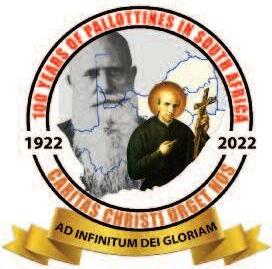
Bishop Hennemann, six weeks shy of his 40th birthday that day, had been the bishop of Cameroon since 1913. Back then, Cameroon was a German colony, but after World War I, the Ger man colonies were reallocated to France and Britain By then, the German mis sionaries, including the bishop, had been expelled from Cameroon. That is how Hennemann and his eight fellow Pallottines ended up in South Africa
The bishop came to serve as the prefect of the Cape of Good Hope vicariate, which covers today’s Oudtshoorn dio cese. In 1933 he’d become the bishop of Cape Town, ser ving in that position until his retirement in 1949
Within four days of landing in Cape Town, the missionaries arrived in Oudt shoorn. There were few Catholics in the region, and almost all were white: 400 in Oudtshoorn, 150 each in George, Mossel Bay and Beaufort West, and 60 in Knysna The Pallottines set to work, with Br Johannes Tenhaf becoming known as a builder of structures, in Oudtshoorn and in Cape Town

Meanwhile, in 1932, Br Michael Busam, like Br Tenhaf one of the original Pallottines in South Africa, set up a printing press for the production of ma terial used in the Afrikaans apostolate. Chief among these was the journal Die Katolieke Wereld, long edited by Fr Wil helm Fell SAC, another German, who also translated the first Afrikaans chil dren’s catechism and taught the lan guage to many missionaries. The printing press closed in 1960, and the journal after 1965 published by the bishops’ conference folded in 1974 Bishop Hennemann’s first priority was to build mission stations for coloured people, and to that effect called Pallottine Sisters to come to South
Africa, to work in nursing and educa tion The first Pallottine Sisters arrived on June 1, 1923 Six weeks later, the first school for coloured children opened at North End in Oudtshoorn, followed two weeks later by the first church there
The Pallottines’ early work in that remote part of the countr y impressed the apostolic delegate, Archbishop Bernard Gijlswijk, who asked the con gregation to work in the Eastern Cape. So Fr Francis Vogel, the superior, and Fr Rackle went to Port Elizabeth in 1925. But they were less than welcome there Bishop Hugh MacSherry, the formidable head of the local vicariate, was not keen to have a bunch of Germans muscle into his territory (and the money its people had). As a compromise he allowed them to do mission work among the Xhosa and coloured communities in the Queenstown area. In 1927, they finally began their apostolate, based at Wood lands mission near Stutterheim Without income from Europe, the
Pallottine missionaries toiled hard to maintain their mission, which soon be came independent, by Vatican decree Mgr Vogel, overworked and stressed out, died of a stroke on May 11, 1935 For his burial, the missionaries had to take out a loan.


His successor, German born Mgr John Baptist Rosenthal, was barely in his thirties, but he had a clear vision of what he wanted: a well run ecclesiastical ter ritory with beautiful churches and an ef ficient health, education and evangelising infrastructure He built one mission after another, as well as schools and clinics.
In February 1940, Queenstown was elevated to the status of apostolic prefec ture, and Mgr Rosenthal became its first prefect, and thus Queenstown diocese’s first bishop He remained in that posi tion until he retired in 1972, three years before his death
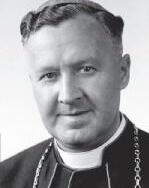
Bishop Rosenthal was succeeded by two more German born Pallottines, Bishops John Rosner (1972 84, a former editor of Die Katolieke Wereld) and Her bert Lenhof (1984 2009) After the eight year stint of Bishop Dabula Mpako, a diocesan priest who is now archbishop of Pretoria, in 2019 Pope Francis ap pointed a locally born Pallottine in Bishop Siphiwe Paul Vanqa.
By the time Mgr Rosenthal was ap pointed prefect of Queenstown, Oudt shoorn already had its second Pallottine bishop, Mgr Theodore Koenig (1934 47) He had arrived with Bishop Hennemann in 1922 (as the only one of the group not to have ser ved in Cameroon) and succeeded Hennemann upon his ap pointment to Cape Town. Bishop Koenig would be succeeded by two con freres, Bishops Bruno Hippel (1948 68) and Manfred Gottschalk (1969 82, who died at the absurdly young age of 50)
By 1948, the Oudtshoorn and Queenstown Pallottines merged into one province, with its headquarters in Queenstown There Br Charles Stamm, who had come from Germany as a male nurse, started breeding award winning Ayrshire cattle to provide additional sources of income for the missions through a dair y and a butcher y Tragi cally, Br Stamm was murdered on Febru ary 24, 1985.
Other initiatives followed the ever
extending farm, including a retreat house and youth centre. Meanwhile, a Schoenstatt shrine was built in Queen stown in 1957
The local headquarter for the Pallot tines in South Africa remains at Pallotti Farm at Queenstown
In the late 1980s, the Pallottines ex tended to KwaZulu Natal, with the pur chase of the Dominican premises at Merrivale, near Pietermaritzburg, to ser ve as a home for Pallottine students at St Joseph’s Theological Institute at Cedara, with Fr Barry Reabow serving as rector, followed by Fr Vanqa The house turned out to be a disappointment: none of the students there progressed to the priesthood, and two of its priests, Frs Rudolph Koeble and Dominic Nxala, died in car accidents, in 1993 and 1997 respectively

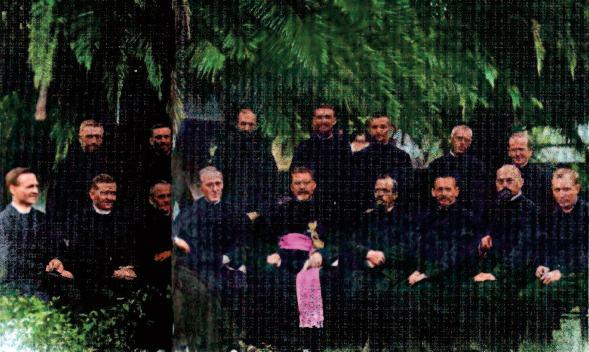

Things improved after the Pallottines called Fr Peter Hillen, another German of the order, from his appointment in Cameroon to assist with vocation promo tion and formation in South Africa His appointment was a success It saw the purchase of the Redemptorist Sisters premises, later to be known as St Vincent Pallotti Formation House, in Merrivale. It has flourished, with vocations from South African and also from Malawi,
Local vocations always were a con cern for the congregation It was not so much a problem when there was a regular flow of missionaries from Germany (most of whom eventually returned home), but even then, in the 1930s the Pallottines es tablished a minor seminary at Swellen dam It closed when German priests were interned during World War II.
The Pallottine spirituality has found its way into the locally formed congrega tion of Sisters and a group of lay faithful The Sisters of Our Lady Mother of Divine Love (or Ntaba Maria Sisters, as they are popularly known) in the diocese of Queenstown, are one example. The lay Sodality of St Vincent Pallotti is active in Queenstown and Oudtshoorn Bishop Hennemann brought the

first Pallottine Sisters to South Africa within a few months of his arrival here. When he became bishop of Cape Town in 1933, he brought yet more Sisters over. They started a hospital and a home for orphans and handicapped children, both dedicated to St Joseph and both still in existence Currently 11 Pallottine Sis ters work in the Cape Town archdiocese
Although the congregation never had a strong profile in the Mother City, the name of its founder is better known there than anywhere else in South Africa, even outside Catholic circles That is thanks to the St Joseph’s Sanatorium which the Pallottines built in Pinelands in 1938 Over the years, it developed into a world class hospital
Today the well known hospital is no longer Catholic owned, but it retains the name which replaced that of St Joseph: Vincent Pallotti.
has most often been won by traditionally Catholic nations, as Günther simmermacher explains.
WHEN THE CONFETTI descends upon the winners of the football World Cup in Qatar on December 18, chances are good that the celebrating team will come from a traditionally Catholic country.
Only two countries from non major ity Catholic countries have ever won the World Cup Germany (four times) and England (once) And the winning German sides of 1954 and 1974 were dominated by players from traditionally Catholic regions of their country: Rhineland, Palatine and Bavaria Even the German team that won in 2014 was coached by a former altar boy, and all time World Cup record goalscorer Miroslav Klose is a devout Catholic.

The other winning nations Uruguay (twice), Italy (four times), Brazil (five times), Argentina, France (twice each), and Spain (once) are tradition ally Catholic countries That doesn’t mean, of course, that all the players are Catholics The French sides that won the cup in 1998 and 2018, for example, were remarkably multicultural. Still, the world’s four greatest footballers of the past decade, all of whom are set to com pete this month, profess to be Catholics.

Portugal’s Cristiano Ronaldo frequently forms his hands in prayerful style, looking heavenwards. According to reports, he actually is praying when he does that He also wears a rosary and collects holy items. “I am Catholic and I go to thank God for everything he gives me,” Ronaldo has said “I don’t ask for anything thanks to God, I have everything I simply thank him for protecting my family and friends ”

Lionel Messi of Argentina described meeting his compatriot Pope Francis in 2013 as one of the biggest highlights in his life, one full of memorable moments. The player often crosses himself, and has been seen wearing a rosary He is rumoured to have made a pilgrimage to Medjugorje, though that has also been strongly denied
Messi wears his faith on his sleeve, literally On his right shoulder, the player has a tattoo of Jesus with the crown of

thorns, and on his forearm a rosary He also has a tattoo of the Sagrada Familia basilica in Barcelona, the city where he played for most of his career
Polish striker Robert Lewandowski is a practising Catholic He once said: “I am a Catholic and I am not ashamed of Jesus or my faith, because I know that God is surely watching over me all the time. When it comes to faith, in modern life and in the world, everything goes very quickly We often forget about our values and what is really most important to us Faith helps me be a good person on and off the pitch and make as few mistakes as possible ”

One may argue about who is the best goalkeeper in the world, but any body who doesn’t say it’s Germany’s Manuel Neuer is mistaken The 36 year old Bayern Munich keeper is a commit ted Catholic from a devout family Neuer doesn’t speak about faith, but he lets his actions do the talking: he has a charita ble foundation for children in rural areas and financially supports a youth group run by a group of friars

Brazil has the world’s largest Catholic population, but the Pentecostal and evangelical churches have success fully proselytised in the country The nation’s football team includes several players from that wing of Christianity as well as Catholics. Together Brazilian players have a long history of expressing their faith on the pitch, but in 2018 their football association banned such displays (in line with FIFA’s guidelines)
There are many more Catholic players participating in the World Cup Part of the fun for Catholics is to spot them as they make the sign of the cross after scoring or entering the pitch And this year, such gestures will be made in an Islamic country
Although Qatar is relatively tolerant of Christianity, a religion followed by many of its migrant workers, it has a very poor human rights record. Even some stars who will compete in this year’s World Cup, which kicks off on November 20, have voiced their objections to Qatar hosting the event.

For many observers, Qatar’s hosting of high profile events amounts to “sportswashing” This is the practice by which governments (or corporations) use sport to gloss over their blemished reputation. They do so by hosting high level events (such as a World Cup, F1 races, and so on) or by buying sports teams which they financially dope to become hugely successful (such as Manchester City, Paris Saint Germain or Newcastle United)
As football fans watch the World Cup this month, they ought to keep in mind the propaganda properties of the event, and the mendacity of FIFA which chose Qatar, and Russia before it, to host it But we may also rejoice at moments of great football, and on the Fourth Sunday of Advent applaud the winner whether it is a traditionally Catholic country or not
SHEIS THE SAINT WHO GAVE US the second verse of the Hail Mary: “Blessed art thou amongst women, and blessed is the fruit of thy womb, Jesus ” St Elizabeth expressed these sentiments when the newly preg nant Mary visited her in the Judean hill country.
Tradition places that encounter in Ein Kerem, a village near Jerusalem Today two Catholic churches there re member St Elizabeth One is the church of the Visitation on top of a hill, where Elizabeth’s encounter with her cousin Mar y, and Mar y’s “Magnificat”, are re membered The other church marks St Elizabeth’s other great contribution to the Gospel: the birth of John the Baptist who would prepare the way for the Lord.
We do not know exactly when or where Elizabeth was born. Since she was said to have been significantly older than Mary according to Luke she was past the normal child bearing age when she was pregnant with John one may time her birth to 40 50 BC.
Tradition places Mary’s birth in Jerusalem, so it is likely that her relatives also hailed from the Holy City or sur rounds This may include Elizabeth Elizabeth came from a family in the

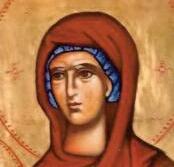

priestly line of Aaron. Elizabeth was married to Zechariah, who was a priest, also in the line of Aaron The couple was appar ently well off, maintaining two residences, one in the village and the other on top of a hill, near a spring. According to St Luke, they con ducted their lives with virtue and fidelity to the Commandments Their great sor row, and public embarrassment, was not having been able to conceive a child
The couple’s story enters the Gospel when they were at what Luke calls an “advanced age”, which in a time of low life expectancy meant something differ ent to our modern understanding
One day Zechariah went off to Jerusalem to do his priestly duty in the Temple. That week, his task was to per form the incense offering As he was doing his job at the altar, an angel of the Lord appeared to him, conveying star tling news: Zechariah and Elizabeth would have a son Regardless of the par ents’ preferences, the boy would be called John and he would be the forerunner of the Messiah

Quite reasonably, Zechariah was du bious about all of this and asked for a sign that might prove the prophecy The angel then introduced himself as Gabriel,
declared himself to be on a mission of God and since Zechariah was doubting him and wanted a sign, he would be struck dumb until the birth of the child.
After this extraordinary encounter, Zechariah went to the outer court of the temple to impart the customary blessing to the waiting faithful But he couldn’t speak
After the speechless Zechariah re turned home, Elizabeth duly conceived, as promised by the angel “The Lord has done this for me, now that it has pleased him to take away the humiliation I suf fered in public,” Elizabeth said, noting a prevailing prejudice against childless women
She moved into the hilltop residence where she spent the next five months in seclusion Elizabeth was five months pregnant when her young cousin Mary from Nazareth arrived at the residence Having been told by the angel Gabriel that Elizabeth was pregnant, the teenage girl had made the long and hazardous journey from Nazareth in Galilee to the Judean hill country She would remain there for three months, returning home before her own pregnancy would make travelling too difficult.
Mary’s visit was a joyous surprise Somehow Elizabeth knew about the na ture of Mary’s pregnancy and so did the child she was carrying, for it leapt for joy in her womb. She greeted the girl with the words: “Of all women you are the most blessed, and blessed is the fruit of your womb Why should I be hon oured with a visit from the mother of my Lord? Look, the moment your greeting reached my ears, the child in my womb leapt for joy. Yes, blessed is she who be lieved that the promise made her by the Lord would be fulfilled” (Luke 1:42 45). Whereupon Mary responded with what we now call the “Magnificat”
Having returned from the hilltop res idence to the family home in the village


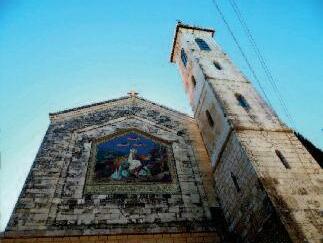
ABOUT 8KM SOUTH WEST OF the Old City of Jerusalem is the suburb of Kiryat Ha Yovel With its high rise buildings, it is quite unlike most places pilgrims visit in the Holy Land Before 1948 it was an Arab village called Ein Kerem, the name by which pilgrims still refer to it. Its population was forcibly removed by Israeli troops.
Two thousand years ago, this was the countryside village to which Mary rushed to share the news of her pecu liar pregnancy with her older cousin Elizabeth, who was also pregnant, with the child whom the world would come to know as John the Baptist This served to verify that the Archangel Gabriel had spoken the truth when he revealed to Mary that her cousin was six months pregnant
Two churches mark the homes of Elizabeth and her temporarily dumb struck husband, Zechariah. Set at the foot of a knoll, the church of the Nativ ity of St John the Baptist is said to have been the site of the couple’s regular residence Evidently a family of means, they had a summer residence on top of the hill, where Elizabeth spent most of her pregnancy
The present church of the Nativity of St John was built in the 17th century on top of an old Crusader structure The church was constructed with fund ing from the Spanish royal family As a result, the church has a distinct Spanish feel, with paintings by Spanish artists and blue and white tiles covering the walls.
In the far left corner of the church, a flight of seven steps leads to a crypt which once was a rock cut cave It marks the reputed spot of John the Baptist’s birth with a silver star
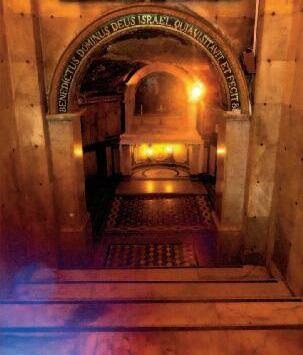
It is a bracing walk uphill to reach the church of the Visitation In its courtyard is a striking abstract statue of Elizabeth and Mary greeting one an other, and on the walls are plaques of the Magnificat in many different lan guages The encounter is represented in a huge mosaic on the exterior of the two level church, which was designed by the master architect Antonio Barluzzi and completed in 1955 It was built above a Crusader church, part of which had collapsed in 1860 During the rebuilding works, the Franciscans discovered a crypt that had been filled with soil and stones After it was cleared of its landfill, the excavation revealed a Roman era subterranean water system It is now regarded as the place where Elizabeth and the infant John hid during Herod’s Massacre of the Innocents A huge rock set in a niche is believed to be the stone that covered the entrance to the refuge.
Luke doesn’t actually give the name of the village; he calls it “the hill country” It was a prosperous area with a rich water supply and fertile land The spring after which Ein Kerem is named (it means “the spring of the vineyard”) is located halfway up the hill, between the two churches, and is now covered by a small mosque Early Christians called it the “Spring of the Virgin” because of a tradition that Mary drank from it on her visit to Elizabeth.
The pilgrim Theodosius in 530 AD links a place that fits the description of Ein Kerem to “Saint Elizabeth, the mother of my Lord John the Baptist” By the 7th century Ein Kerem was widely regarded as John’s birthplace, with the Jerusalem Calendar in 638 marking a festival in honour of St Elizabeth on August 28
This is an edited excerpt from Günther Simmermacher’s book The Holy Land Trek
where everybody was delighted for her Elizabeth gave birth to her miracle baby A grotto in today’s church of the Nativity of St John in Ein Kerem marks the spot of that birth
The baby’s circumcision, on the eighth day after birth, was attended by neighbours, friends and relatives It was taken for granted by all present that the boy would be named after his still speechless father, but Elizabeth confounded the guests when she insisted that the child would be named John.
Not quite believing what they were hearing from the mother, the people con fronted the father Zechariah wrote his re sponse: “His name is John ” At that, Zechariah’s powers of speech returned, as promised by the angel, and he exclaimed a blessing.
Addressing his son, Zechariah said: “And you, little child, you shall be called Prophet of the Most High, for you will go before the Lord to prepare a way for him, to give his people knowledge of salvation through the forgiveness of their sins, be cause of the faithful love of our God in which the rising sun has come from on high to visit us, to give light to those who live in darkness and the shadow dark as death, and to guide our feet into the way of peace ” As John the Baptist, the child grew up to do just that
But first there was jeopardy, at least ac cording to tradition By now Elizabeth and Zechariah have departed Luke’s Gospel But the apocryphal Gospel of James from the 2nd century extends King Herod’s genoci dal search for the infant King of the Jews to their family
While Elizabeth was hiding with John in the hilltop residence the rolling stone which reputedly sealed their hideaway can still be seen in the church of the Visitation Zechariah was questioned by Herod’s sol diers about the whereabouts of his son, who was under two years old and therefore liable to be massacred The father refused to be tray his son and wife, and was murdered.
Matthew 23:35 offers a different the ory. He reports Jesus as referring to a Zechariah who was “murdered between the sanctuary and the altar”. The Church Father Origen suggested that Zechariah was John’s father This would mean that Zechariah was killed by the religious establishment.


As for Elizabeth, the trail on the re mainder of her life goes cold after John’s cir cumcision
Though not named in the Qu’ran, Eliz abeth is also venerated in Islam as a wise and pious woman Islam also honours Zechariah (or Zakaria) and John (or Yahya).
The Catholic Church marks the feast of Ss Elizabeth and Zechariah on November 5. Next month: St Nicholas
Who’s the patron? St Genesius of Rome (died 303) Why clowns? In the 3rd centur y, St Genesius was a comedian who performed in plays that mocked Christianity During one such per formance he had an on stage experience that converted him He was martyred for holding on to his faith in the persecution of 303 AD The protector of clowns is also a patron of lawyers as well as of actors, comedians, con dancers, people with epilepsy, musicians, printers, stenographers, and victims of torture

There’s a patron saint for virtually everything and some of these patronages are quite unusual. But that shows that the saints are always at work for us. Here are five unusual portfolios handled by patron saints.


Who’s the patron? St Vitus (died 303) Why oversleeping? We all may need this saint from time to time, for example when we have an exam or an early flight or a wedding day... For the latter we can invoke St Vitus, another victim of the persecution of 303, for he is also a patron for dancing He teams up with St Genesius in looking after clowns, comedians and actors, but is most widely venerated as th patron saint of epilepsy And why the portfolio of avoid ing an extended snooze? Nobody really knows, but don’t let that keep you up at night, in case you oversleep!
Who’s the patron? St Benedict of Nursia (480 547) Why spelunkers? Well, firstly, what is a spelunker? It’s a funny word for a cave explorer And what does the founder of the Benedictines have to do with spelunking?
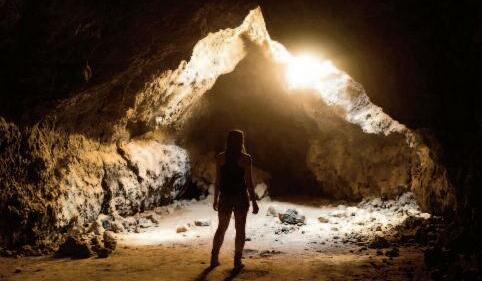














While living in a cave at Subiaco, several people (including monks and a priest) tried to poison Benedict All attempts miraculously fail Aa a youth, Archbishop Denis Hurley vowed to become a priest while he was lost overnight in a cave Did he pray to St Benedict, patron of spelunkers, that night?




Who’s the patron? St Albertus Magnus (c 1200 1280) Why stupidity? God knows, there are many people who need help in that field at some point maybe any of us Albertus Magnus, a Dominican bishop of Regensburg, Germany, is one of the great Christian philosophers and a Doctor of the Church. But when he became rather too impressed with himself, Go taught him a lesson in humility by turning the philosopher into an intellectual ass (and back again) St Albertus is also the patron of natural scientists
Who’s the patron? St Julian the Hospitaller (4th cent ) Why murderers? God’s mercy demands tha even murderers have recourse to him throug saintly intercession Here the idea obviously is not to pray that their evil endeavours succeed, but that they repent and convert What does St Julian have to do with murder ers? Well, his father saw witches putting a cu on the newborn Julian which should make h both his parents. Julian didn’t, and when he learnt of the curse, vowed to never sin again
p

DChristmas, Nativity scenes and Christmas trees decorate most Catholic homes but what about Advent wreaths?
Advent wreaths are traditionally made from evergreen branches and have four candles The four candles represent the four weeks of Advent In many re gions, three candles are purple, and one is a rose colour In other regions, three candles are red and one is white.
The purple represents prayer, penance, and preparation for the com ing of Christ Historically, Advent was known as a “Little Lent”, which is why the penitential colour of purple is used During Lent, we prepare for the resur rection of Christ on Easter Similarly, during Advent, we prepare for the com ing of Christ, both on Christmas and at the second coming
The rose candle is lit on the third Sunday of Advent, known as Gaudete Sunday. At Mass on the third Sunday, the
ments Gaudete Sunday is a day for re joicing and joy as the faithful draw near to the birth of Jesus, and it marks the midpoint of Advent This year, Gaudete Sunday is on December 11
During the Advent season, the faithful will also notice a common theme in the Gospel readings The read ings focus on preparation or “making straight the path of the Lord”, penance, and fasting. All of these things remind us of the importance of preparing our hearts for the Lord and making room for his presence in our lives
The Advent wreath originated from a pagan European tradition which con sisted of lighting candles during the winter to ask the sun god to return with his light and warmth Missionaries took advantage of this tradition to evangelise people, teaching them that they should use the Advent wreath as a way of
p p g , his Nativity, and ask Jesus to infuse his light in their souls.
The circle of the Advent wreath is a geometric figure that has neither a be ginning nor an end It reminds us that God does not have a beginning or an end either, which reflects his unity and eternity. It is a sign of the unending love that the faithful should show the Lord and their neighbour, which must be constantly renewed and never stop
The green colour of the wreath rep resents hope and life The Advent wreath reminds us that Christ is alive among us, and that we must cultivate a life of grace, spiritual growth, and hope during Advent
The blessing of an Advent wreath takes place on the First Sunday of Ad vent or on the evening before the First Sunday of Advent This year, it’s on No vember 27. To bless your Advent wreath at home, follow the guide in the box below.

THE BLESSING OF AN ADVENT WREATH takes place on the First Sunday of Advent or on the evening before that Before the first candle is lit, the household gathers for this blessing. When the blessing of the Advent wreath is celebrated in the home, it is appropriate that it be blessed by a parent or another member of the family
• All make the sign of the cross The leader begins: Our help is in the name of the Lord
All respond: Who made heaven and earth.
The leader may use these or similar words to introduce the blessing: As we celebrate Advent, we realise how we are always needing salvation by our God Around this wreath, we shall remember God’s promise
Then the Scripture is read: Listen to the words of the prophet Isaiah: “The people who walked in darkness have seen a great light; upon those who dwelt in the land of gloom, a light has
shone You have brought them abundant joy and great rejoicing” (9:1 2 )
The reader concludes: The Word of the Lord
All respond: Thanks be to God
After a time of silence, all join in prayers of intercession and in the Lord’s Prayer
Then the leader invites: Let us now pray for God’s blessing upon us and upon this wreath.
After a short silence, the leader prays: Lord our God, we praise you for your Son, Jesus Christ: he is Emmanuel, the hope of the peoples, he is the wisdom that teaches and guides us, he is the Saviour of every nation.
Lord God, let your blessing come upon us as we light the candles of this wreath. May the wreath and its light be a sign of Christ’s promise to bring us salvation; may he come quickly and not delay We ask this through Christ our Lord
n the northern hemisphere, Advent is in the cold winter, and seasonal food and drink is meant to warm you up. Here in South Africa, Advent is in summer, and our seasonal menu reflects that
My easily made Caprese wreath is a great addition to your festive table Not only is it a deli cious and popular salad, but it also makes an attractive table centre piece Enjoy it as an appetiser or ser ve it as a side dish; it is the ideal companion to hot or cold dishes, meat, fish or poultry preparation: 15 min • servings: 4

ste


1 Gently wash and dry the basil leaves and baby spinach
2 Arrange the baby spinach leaves decoratively around the edge of a large round (ideally white) platter
3. Arrange the bosa tomatoes and bocconcini mozzarella on the spinach leaves, and then scatter basil leaves inbetween

4. When ready to serve season to taste and drizzle olive oil and bal samic glaze.
5. Enjoy with an Advent prayer!


Anybody who cooks for Advent and Christmas knows the hassle of suddenly needing an ingredient left off the shopping list, the nuisance of leftover foodstuffs, or the emergency of needing a side dish Grazia offers some ideas that may provide relief
• Forgot to buy breadcrumbs? Make your own bread crumbs with leftover bread Toast it and then blend in a food processor to fine or medium crumbs Store the breadcrumbs in an airtight container
• Leftover double cream and don’t know what do to with it? Just add a few tablespoons of crunchy peanut but ter, a few drops of vanilla essence, whisk together, then sift some icing sugar for sweetness Freeze for a few hours and you’ll have your own peanut butter ice cream!
• Overripe bananas? Freeze the bananas until you can use them They are great for baking banana loaves or making smoothies
• Leftover roast chicken can be used in delicious sandwiches for lunch or a snack Cut the chicken into strips or cubes and mix with mayonnaise, salt and pepper. Add lettuce, tomato and perhaps coleslaw to add extra flavour
• Leftover salmon or beef steak? Use in a salad the next day Cut in strips, it’s perfect in a rainbow slaw, or tossed with olive oil and balsamic glaze
• Too many tomatoes? Cut them up and make into a delicious pasta sauce Just add fresh basil, salt, pepper, and olive oil (add sugar to taste if the tomatoes are tart) Add all ingredients to a pot and simmer for 20 30 minutes If you don’t need the sauce, freeze for one of those busy days when you don’t feel like cooking
• Not sure what to do with uncooked courgettes? Just rinse and pat the babymarrows dry, then dip them in flour Egg wash the vegetables (in eggs with salt and pepper), then fry in hot oil till golden A tasty snack or side dish
• Leftover eggplant? Slice and bake the aubergines till slightly soft, spread spinach and ricotta over the slices and roll up the brinjals Place in an oven proof dish, cover with tomato sauce (see above), and sprinkle with grated lla Bake till cheese is golden and every hing is heated, around 20 25 minutes
• Fresh herbs make such a difference to dishes If you have leftovers they can be frozen in an ice cube tray Just rinse, pat them dry, then freeze till needed

CATHOLICISM INFUSES LIFE in Upper Bavaria, the southern part of Germany’s largest state, which always regards itself as a bit apart from the rest of the countr y. You hear it in the common greeting, “Grüß Gott” (roughly, “Greetings in the name of God”); you see it on the many beer labels that bear the names of Catholic orders and cloisters; and you are reminded of it as you pass the abundant roadside shrines
The active practice of the faith may be diminishing even in conserva tive Bavaria, but Catholicism is ever present perhaps nowhere more so than in Oberammergau, site of the famous Passion Play As they have done every ten years for almost four centuries, the villagers of this small town of just over 5 000, about 90km southwest of Munich, came together this year to stage an extravagant and moving narrative of the Lord’s Passion. Only people born in Oberammergau or long standing residents may take part in the play. About half of the village gets involved in performing it
The Passion Play’s scale goes be yond a mere stage performance: this is an expansively crafted spectacle on a

45m wide stage, with a huge cast (which includes a donkey, horses, sheep, doves and two dromedar y camels), a superb choir, and tableaux vivant living pictures featuring perfectly still actors linking the Old Testament to the Holy Week narrative.
The Souther n Cross pilgrims who saw this year’s play enjoyed an advantage over other spectators, having seen the actual places of Jesus’ Passion in Jerusalem just a couple of days earlier they even had a Mass inside the tomb in which Our Lord rose from the dead
As it was when a Souther n Cross group saw the Passion Play in 2010, this year’s pilgrims saw Jesus por trayed by Frederik Mayet, who fea tured on the cover of our April issue and was inter viewed by us in May

During the break in the perform ance, Archbishop William Slatter y and I met up with Mayet and Christian Stückl, the play’s accomplished direc tor and playwright. The cast members having a smoke outside the canteen joked that the director’s stressed demeanour was his normal state It would be understandable: this play requires exact choreography and discipline from its lay actors Pulling
all this together so seamlessly almost daily borders on the miraculous

Stückl has crafted a masterful script He has translated important discourses in the Gospels from Galilee to Judea to communicate the nature of Jesus before we see him killed by men. Judas in this account is a tragic figure who didn’t act out of greed and treach ery, but in a foolish, misjudged bid to politically radicalise Jesus The schem ing high priests Caiaphas and Annas are presented as being concerned more with the political than theological impact of Jesus of Nazareth The real villain of the piece is Pontius Pilate, ahistorically dressed to look like a fascist strongman (as are his soldiers)
The viewer is left even more shocked at this show of the “banality of evil” than one might be at the parade of villainy in the more tradi tional presentations of the Passion. At a time when peace and democracy are under real threat worldwide, the Pas sion Play conveyed a potent message
The next Oberammergau Passion Play will be held in 2030, and again in 2034, for a special run to mark the 400th anniversary of the first staging.
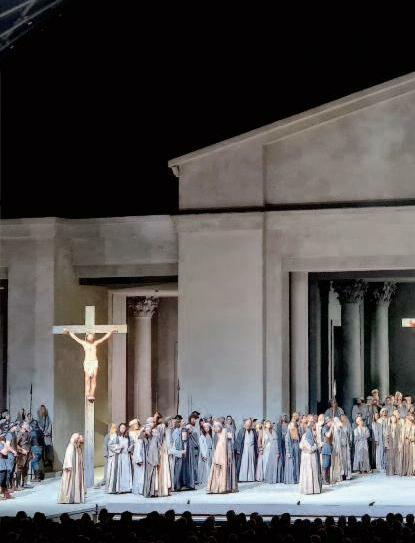
The day after seeing the Passion Play, our group visited the Benedictine Ettal Abbey and had Mass there An architectural marvel, Ettal Abbey is a tourist and pilgrimage destination The Benedictine motto “Ora et Labora” is evident here The 50 resident monks pray here, but they also run a brewery, a distillery, a bookstore, an art publish ing house, a hotel, and even a cheese factory. Its boarding school, however, will close soon The abuse scandal also hit that part of the world
The pilgrims then visited one of

T h e C a t h o l i c f a i t h i s s t i l l e v e r y w h e r e i n B a v a r i a , a s S o u t h e r n C r o s s p i l g r i m s t o t h e O b e r a m m e r g a u P a s s i o n P l a y s a w . G ü n t h e r S i m m e r m a c h e r s h a r e s h i s i m p r e s s i o n s o f G e r m a n y ’ s l a r g e s t s t a t e .S o u t h e r n C r o s s p i l g r i m s o u t s i d e E t t a l A b b e y a n d i n s i d e t h e P a s s i o n P l a y t h e a t r e i n O b e r a m m e r g a u , w i t h A r c h b i s h o p W i l l i a m S l a t t e r y a t l e f t i n f r o n t C r u c i f i x i o n s c e n e a t t h e O b e r a m m e r g a u P a s s i o n P l a y
Bavaria’s most popular pilgrimage destination, the gorgeous Rococo style Wieskirche, built in the 1740s to serve the many pilgrims to its miracu lous statue of the Scourged Christ (which, of course, tied in with the pil grimage’s Passion theme) The Wieskirche’s ground used to be re strained in its commercialism In 2010, there were still only two huts accom modating tourist shops There are more now, though they are not yet in vasive in number In any case, pilgrims want to buy souvenirs and ice creams; the vendors provide for that need.


Souvenir shops were also in ready supply in Germany’s most important Marian shrine, Altötting, which my wife and I visited privately after the Passion Pilgrimage The shrine is located near the Austrian border, and only 12km from Marktl am Inn, the village where Pope Benedict XVI was born (which we, of course, also visited) The object of pilgrimage in Altötting is the wood carved statue of the Black Madonna The story goes that in 1489, a mother placed the
drowned body of her three year old son before the statue of the Virgin Mary on the altar of the local chapel, whereupon the child was revived

Today, Altötting has several pilgrim churches, all clustered around the chapel of the Black Madonna. One of them is dedicated to Capuchin Brother Konrad (1818 94), who over his four decades of curating the shrine established a reputation for holiness, prophecy, and miraculous healings He was canonised by Pope Pius XI in 1934
Bavaria has many sites of pilgrim age, most of which are utilised by lo cals, such as the Franciscan monastery of Maria Eck near Traunstein, where my wife and I had an open air Mass on the day of our departure The abbey can still guarantee Masses; but many parishes, especially in the more rural areas, suffer from shortages of priests, resulting in Communion services increasingly becoming a norm.






Some churches are popular desti nations for secular tourists, too. One of them is the 17th century chapel of

St Bartholomew, which can be reached only by (strictly electrically powered) boats on the majestic and clear lake Königsee, near Berchtesgaden

The red domed St Bartholomew’s sits within a nature reserve which is unmanaged by human hand In the forest lie many trees that were brought down in an avalanche in 1999. They will eventually rot away while the forest keeps regenerating itself It is a good place for contemplating the urgent message of Pope Francis’ encyclical Laudato Si’ The manage ment of the Königsee and the nature around it gives a good example of how we ought to care for Creation
Coming from South Africa where the Catholic Church is at the margins and carnivals are celebrated at any random time of the year the ubiquity of Catholic expression in lands where the faith is at the centre, at least nominally, provides for a pleasant culture shock It manifests itself in the great churches, such as Munich’s Frauenkirche (which our pilgrims visited), and it also does so in the small shrines on lonely roads.
 The Southern Cross
The Southern Cross

The idea of humanity’s dominion over nature has proved disastrous, and the stewardship model is flawed. But there is a third way, Terence Creamer writes
T HE WAY CHRISTIANS PERCEIVE creation has a profound, some times destructive, influence on how we interact with the natural environment Franciscan Father Dan Horan, who toured Southern Africa earlier this year as part of the Jesuit Institute’s Winter Living Theology lecture series, be lieves that the “paradise consciousness” of St Francis of Assisi and Fr Thomas Merton provides a powerful alternative model one premised on humanity’s deep inter connectedness and its full dependence on creation, rather than one of domination or even stewardship
Fr Horan, director of the Center for Spirituality and professor of philosophy, re ligious studies and theology at St Mary’s College in Notre Dame, Indiana, argues that three models of creation have shaped Christian environmental consciousness over the centuries: the Dominion, the Stewardship and the Kinship models
The Dominion Model, he says, arises from an interpretation of Genesis 1:26, where God gave human beings “dominion over the fish of the sea, and over the birds of the air, and over all the wild animals” This is typically quoted together with God’s instruction that humanity should “fill the earth and subdue it” (1:28).
Conscious, or unconscious, adopters of the model argue that human beings are the centrepiece of God’s creation and that everything else has been created for hu manity to “use as we please” In other words, it’s a sense of sovereignty that sets humanity apart from and above the rest of the natural world
The negative environmental conse quences of such an interpretation have been far reaching and are visible in every thing from the extinction of species and the destruction of natural forests, through to high levels of air and water pollution, and increasingly in the floods, fires and droughts being triggered and/or amplified by climate change

The scriptural, theological and scien tific contradictions associated with the Do minion Model have led Christian scriptural scholars and theologians to re examine how Genesis should be read and under stood Most are now aligned with the sen timents expressed by Pope Francis in his encyclical Laudato Si’ that such an interpre tation is “not a correct understanding of the Bible as understood by the Church”
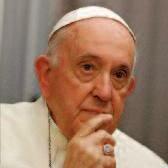
As a result, a Stewardship Model has
emerged as the dominant framework for understanding creation and humanity’s re lationship with creation. While the ap proach continues to view humanity as special and, thus, separate from creation, the universe is understood to be God’s “household” which human beings are en trusted to care for as “good stewards” The model is arguably reflected in the full title of Laudato Si’ , with its subtitle, “On Care for our Common Home”
The Stewardship Model takes its lead from Genesis 2:15, which states: “Then the Lord God took the man and put him in the garden to till it and keep it” in other words, to be good gardeners and landlords for all of creation. The model, Fr Horan explained, assumes that humanity has a “vocation, a divine man date and a responsibility to care for the rest of creation” and represents a signifi cant improvement on one that suggests that nature should be subdued. “We are intermediaries both ‘ha adamah’ [earth] and ‘Imago Dei ’ [Image of God] serving to represent nonhuman creation to God ”
Nevertheless, human beings continue to stand at the centre, albeit without absolute free rein “The intrinsic relation ship humanity has with non human creation by virtue of being part of creation is downplayed and our ‘distinctiveness’ is overly emphasised,” says Fr Horan
Fr Horan believes that scripture, as well as the teachings of St Francis and the writings of 20th century American Trappist monk Thomas Merton, are pointing to an


encyclical, the title of which is taken from the first two Italian words of St Francis’ famous “Canticle of the Creatures”, which in its English translations starts with the words “Praise be”.
Described as the Kinship Model, or the Community of Creation Model, this approach seeks to recognise humanity’s profound interconnectedness with all creation Fr Horan stresses that such an approach, while not currently widely recognised or embraced, is not novel It is reflected in St Francis’ well known love for animals and his kinship even with those inanimate parts of the created order, such as the sun, the moon, and the earth, which he termed brother, sister and mother.
“Often the Canticle is romanticised But the heart of St Francis’ nature mysticism is a deep understanding of our interconnection, our interdependence and our interrelationship with all of creation,” Fr Horan asserts

The Kinship Model starts from a recognition that human beings “are cre ation” and are not separated from it, as emphasised in Genesis 2 that humanity is from the dust of the earth and is, thus, made from the same elements that make up the rest of creation “We are part of the same family; we share a deep DNA that is so close to the DNA found in everything else around us, and on an atomic level [that] we are almost indistinguishable from the rest of creation,” Fr Horan notes
This realisation, Horan argues, is not something to be feared but to be cele brated, as Thomas Merton showed in his meditation on the trees, which is found in his 1949 book New Seeds of Contemplation: “A tree gives glory to God by being a tree. For in being what God means it to be it is obeying God It ‘consents’, so to speak, to God’s creative love It is expressing an idea which is in God and which is not distinct from the essence of God, and therefore a tree imitates God by being a tree ”
Reflecting his growing awareness of humanity’s kinship with creation, Merton wrote in 1963: “How absolutely true, and how central a truth, that we are purely and simply part of nature ” Similarly, Pope Francis prays in Laudato Si’: “Teach us to discover the worth of each thing, to be filled with awe and contemplation, to recognise that we are profoundly united with every creature as we journey towards your infinite light ”
For Fr Horan, humanity’s intercon nectedness is not simply poetic or senti mental. “Instead, it is a statement of the most profound truth affirmed by both science and religion ”

ALMOST CHRISTMAS! THAT time of the year has almost just begun. The supermarkets are, rather annoyingly, inviting us to splurge on mince pies, malva puddings and fruitcake. Boney M’s “Feliz Navidad” is tickling our ears many weeks before that Happy Christmas Strange arts and crafts style creations resembling Christ mas trees are descending upon us
And yet, painfully so, the year has not ended and we find ourselves stretch ing for the finish line November has a funny way of tricking us into thinking that it’s all over, only for us to turn the corner and find that there is still another month to go
Before we can get to the exciting seasons of Advent and Christmas, in No vember the Church calls us to contem plate the lives of the saints and to pray for all the holy souls in purgatory This helps those souls, and it also helps us to have hope in the life that awaits us Through the examples of the saints, we can learn how best to prepare for the life that God desires for us
It has not been an easy year for me I have witnessed a family face hunger. I have seen a business with customers struggling to pay Most of us, vaccinated or not, have narrowly escaped the claws of the coronavirus To this dreadful pan demic I say: ”Banish ye foul plague to the narrow depths from which thou camest!”
Worst of all, there has been death; too much death. I’m tired of all this dying and burying the dead. I need life!
Now more than ever, we need the reassurance that we are not alone Let’s remember this: “Therefore surrounded by so great a cloud of witnesses, let us rid ourselves of ever y burden and sin that clings to us and persevere in running the race that lies before us while keeping our
eyes fixed on Jesus, the leader and per fecter of our faith” (Hebrews 12:1)



In this month, we also celebrate the solemnity of Christ the King. Our world is facing a crisis of leadership Some leaders do not exercise their power at all, while others consume their power like tap water We can see that this has led to state inefficiencies, war and its subsequent displacement of families In our churches, those in charge are some times afraid to conquer the evil that is at work and those who do have the courage often stand alone
It is for these reasons that it is ab solutely imperative that we pray We need to pray ver y hard We need to storm heaven with our prayers. These are dark times and we need the reign of Christ the King to rule over our hearts, our families, our schools, our hospitals, our roads, our places of work and most especially within the Church

So it’s almost Christmas It’s almost time for awkwardly handmade Nativity scenes, cheesy Christmas movies and Christmas carols Let us enter the sea sons of Advent and Christmas with peace, joy and great anticipation of the birth of the Saviour.


This world will pass away, its tower ing buildings will fade, and its clamour will turn to a silence. But before then, we can rejoice with the angels and saints in heaven It’s almost Christmas prepare for him who brings light. Think not of the dark but of that most holy night

I’m tired of burying the dead. I need life!

YOU ARE A FAN of monarchies or not, it was impossible to ignore the impact on the world of the death in September of Queen Eliz abeth II This was in part because of the extraordinary 70 years of her reign, and also the breadth of the people and the countries whose lives she touched.
One may have an impassioned de bate about the person of the monarch and about the value of a hereditary head of state, but this is not the place to do so However, I would like to use her death to explore something of her con tribution to Christianity and of the role of her particular denomination
Her funeral, watched by billions of people worldwide, was very firmly in the Anglican tradition. Many people will have marvelled not just at the pomp and circumstance of British royal ceremony but also at the quiet dignity, elegant lan guage, prayerfulness and transcendent music of the religious aspects of the ser vice. The Church of England are masters at liturgy
The location, Westminster Abbey, is where she was married 75 years ago, where she took her vows as monarch in 1953 (mirroring the Old Testament religious ritual of anointing kings), and where, in about a year from now, her son, Charles III, will be crowned. It is an abbey, not a cathedral, because since its creation possibly in the 7th century and then for about 900 years, it was a monastery with monks and an abbot
The English Reformation under Henr y VIII involved the mass destruc tion of religious houses (“the dissolution of the monasteries”) While all monastic communities were scattered, some buildings, like Westminster Abbey, were spared and an important aspect of monastic life was retained: the daily singing of the office of hours
The reason why the singing at the Queen’s funeral was so extraordinary is because at the abbey, and in every cathe dral and many, many churches in the Church of England, the ancient tradi tion of singing the psalms at set times during the day has been honoured, week in and week out, for centuries Thus, matins and vespers are very much part of the public liturgical life of Anglicans On the other hand, this ver y Catholic medieval tradition has been all but lost to the vast majority of Catholics, and
obser ved only as a muttered private practice by most priests
I make this point because to under stand Anglicanism, we need to bear in mind that they are a Church that sees it self as both catholic and reformed: draw ing on the best from both movements in Church history; recognising the value to take the cue from the title of a famous Anglican hymnal of both “Ancient
and Modern”. The reason why British monarchs use the title “Defender of the Faith” is that Pope Leo X granted it to Henry VIII for defending Catholic doc trine against the reformers before the king’s break with Rome

Reform always takes courage it is tempting to just carr y on doing things the way they have always been done It took great courage on the part of the bishops at Vatican II to recognise that the Catholic Church needed reform And it also takes wisdom As the Council Fathers learnt, and as we have had to struggle with as a Church in the last 60 years, judging what to change and what
to keep is a constant challenge Too much reform and we lose our roots; too little and our branches become lifeless and impotent
I see the Anglican Church as having performed a great service for the wider Christian community through its will ingness to test the edges and to try new things, recognising that sometimes this will be hard When Archbishop Denis Hurley, on behalf of all English speaking bishops worldwide, started the process through ICEL of creating a Catholic liturgy in English, he had the great bene fit of being able to draw on a 450 year “experiment” by the Church of England to make Scripture and prayer accessible to English speakers in their own language.
If or when Catholics return to the ancient tradition whereby most priests were married, we will be able to learn from the experience of denominations like the Anglicans, where parishes have coped comfortably with a clergy who are married and have children. In fact, the hundreds of Anglican priests who have become Catholic priests in the last 20 years, and have kept their wives, means perhaps that the “pilot” is already underway
If or when Catholics start contem plating the priestly role of women in the Church, again there will be lessons we can learn from the Anglicans. Should our Church ever be willing to actually admit the faithful contribution of LGBT+ peo ple to our parishes, our families and our religious life, we will be able to draw on the difficult but necessary conversations that have been happening in the Angli can Communion
Queen Elizabeth II herself had been part of that process of change While re maining a faithful Anglican, she had also witnessed huge changes in practice over her reign, not least the fact that her son can have a divorcée as his queen When she took her oaths as monarch, she promised “to the utmost of her power, to maintain in the United King dom the Protestant Reformed Religion established by law”
And yet, she was the first British monarch since the Reformation to meet a pope visiting five of them in the Vatican and welcoming two of them to the UK. She enjoyed warm relations with a number of Catholic bishops most especially with the late Basil Hume
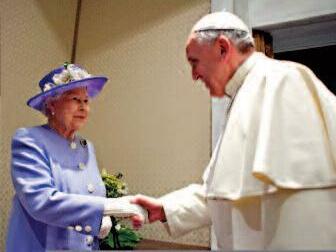
OSB of Westminster She invited Catholic clergy to preach at royal churches and she herself attended a service at a Catholic cathedral
The most striking change in her lifetime has been the removal of the prohibition on British monarchs (or their spouses) being Catholic: in 2015, the 1701 Act of Settlement was finally reversed This, coupled with her personal commitment to ecumenism, has enabled the queen to play an exemplary role in foster ing reconciliation in the north of Ireland. This was demonstrated in the respect she showed to the Irish president, the Gaelic language, the 1916 freedom fighters, and the cur rent Nationalist politicians (and the reciprocal respect recently shown her by Republican Ireland) There are still differences of political opin ion, but her actions show that they cannot be legitimised by invoking religious difference.
All of this is at the grand scale and perhaps should be expected of a head of state overseeing change in the modern age But there is one way in which Elizabeth II never changed: and that is the deep and public devotion she had to her faith In modern Britain, religion is barely mentioned or, if it is, as a problem to be solved or an awk ward private eccentricity The name of Jesus is hardly heard in the UK outside of a church even during “the festive season”; but in her an nual broadcast (to the country and the Commonwealth, the queen publicly placed Christ at the centre of Christmas Her funeral rites again made it clear that her faith in Christ and in the resurrection were not just public pieties
I draw three lessons from Queen Elizabeth’s life which, I think, can inspire us all: her dedica tion to service (which for her was absolutely rooted in her Christian vocation); her demonstration that you can be faithful to your own re ligious tradition and still be open to others; and that in the Anglican way change and continuity are not enemies but two disciples walk ing side by side with Christ.
Guest House, Simon’s Town
Experience the peace and beauty of God and nature with us Fully equipped, with amazing sea views Secure parking, ideal for rest and relaxation Special rates for families, pensioners and clergy Malcolm or Wilma Salida + 27 82 784 5676 or mjsalida@gmail com

INHIS FAREWELL SPEECH, JESUS TELLS us that he is going away but that he will leave us a parting gift, the gift of his peace, and that we will experience this gift in the spirit he leaves behind (John 17:1 26) How does this work? How do we leave peace and a spirit behind us as we go?
This is not something abstract, but something we experience (perhaps only unconsciously) all the time in all our relationships It works this way Each of us brings a certain energy into every rela tionship we have, and when we walk into a room, that energy in some way affects what everyone else in the room is feeling Moreover, it will stay with them after we leave. We leave a spirit behind us.
For example, if I enter a room and my person and presence radiate positive energy trust, stability, gratitude, concern for others, joy in living, wit, and humour then that energy will affect everyone in the room and will remain with them after I have left the room, as the spirit that I leave behind Conversely, even though my words might try to say the contrary, if my person and presence radiate negative energy anger, jeal ousy, bitterness, lying, or chaos, everyone will sense that, and that negative energy will remain with them after I leave, colouring everything I have left behind
The psychologist Sigmund Freud once suggested that we understand things the clearest when we see them broken, and that is true here We see this writ large, for instance, in the case of how a long term alcoholic parent affects his children Despite trying not to do so, he (or she) will invariably bring a certain instability, distrust, and chaos into his family, and it will stay there after he is gone, as the spirit he leaves behind, short term and long term. His person and his presence will trigger a feeling of distrust and chaos, and the memory of him will do the same
The same is true in reverse vis à vis those who bring positive energy, stability and trust into a room Unfortunately, often at the time, we do not sense the real gift that these persons bring and what that gift does for us Mostly it is felt as an unspoken energy, not consciously perceived, and only later in our lives often long after the persons who did that for us are gone do we recognise and consciously appreciate what their pres ence did for us
This is true for me when I think back
on the safety and stability of the home that my parents provided for me. As a child, I sometimes longed for more excit ing parents, and naively felt safety and stability more as boredom than as a gift Years later, long after I had left home and learned from others how starved they had been as kids for safety and stability, I recognised the great gift my parents had given me Whatever their human shortcomings, they provided my siblings and me with a stable and safe place within which to grow up They died while we were still young, but they left us the gift of peace. I suspect the same is true for many of you
This dynamic wherein we bring either stability or chaos into a room is something which daily colours every relationship we have, and is particularly true regarding the spirit we will leave behind us when we die Death clarifies things, washes things clean, especially regarding how we are remembered and how our legacy affects our loved ones
When someone close to us dies, our relationship to him or her will eventually wash clean and we will know exactly the gift or burden that he or she was in our lives It may take some time, perhaps months, perhaps years, but we will eventually receive the spirit he or she left behind with clarity and know it as gift or burden
And so, we need to take seriously the fact that our lives belong not just to us but also to others Likewise, our deaths do not belong only to us but also to our families, our loved ones, and the world We are meant to give both our lives and our deaths to others as a gift If this is true, then our dying is something that will impart either a gift or a burden to those who know us
To paraphrase Fr Henri Nouwen, if we die with guilt, shame, anger, or bitterness, all of that becomes part of the spirit we leave behind, binding and burdening the lives of our family and friends Conversely, our dying can be our final gift to them If we die without anger, reconciled, thankful for those around us, at peace with things, without recrimination and making others feel guilty, our going away will be a sadness but not a binding and a burdening
Then the spirit we leave behind, our real legacy, will continue to nourish others with the same warm energy we used to bring into a room

Every month Fr chris chatteris sJ reflects on Pope Francis’ prayer intention

Intention: We pray for children who are suffering, especially those who are homeless, orphans, and victims of war; may they be guaranteed access to education and the opportunity to experience family affection.

THEONE WHO ACCOMPANIES HURTING CHILDREN t r u l y e n t e r s t h e d e p t h s o f t h e m y s t e r y o f s u f f e r i n g I often think of this when I pass the large children’s h o s p i t a l i n C a p e To w n We r e a l l y b a t t l e t o u n d e r s t a n d , l e t a l o n e a c c e p t , w h y t h e s e i n n o c e n t s e x p e r i e n c e pain and distress at an age when they should be able to play a n d e x p e r i e n c e t h e c a r e f r e e j o y s o f c h i l d h o o d
O u r p e r p l e x i t y i s c o m p o u n d e d w h e n i t c o m e s t o s u f f e r
i n g i n f l i c t e d o n c h i l d r e n b y g r o w n u p s W h e t h e r i t i s t h e R o y h i n g a c h i l d r e n w h o h a v e b e e n m a d e h o m e l e s s b y t h e p o l i t i c s o f M y a n m a r o r U k r a i n i a n k i d s l e f t o r p h a n s b y t h e i n v a s i o n o f t h e i r c o u n t r y, t h e r e i s s o m e t h i n g i n u s t h a t r e volts against the fact that children suffer because of the stu p i d i t y, g r e e d o r d o w n r i g h t c r u e l t y o f a d u l t s I n o u r o w n b e l o v e d c o u n t r y, w e f i n d l a r g e n u m b e r s o f children living in poverty, often having been abandoned by t h e i r f a t h e r s , s o m e t i m e s h a v i n g t o a d o p t t h e r o l e o f a d u l t s a s “ h e a d s ” o f f a m i l i e s , l o o k i n g a f t e r y o u n g e r s i b l i n g s , i n a s t a t e o f c o n t i n u a l i n s e c u r i t y T h e s e e x p e r i e n c e s s c a r o u r c h i l d r e n f o r l i f e , l e a v i n g t h e m e m o t i o n a l l y v u l n e r a b l e a n d e d u c a t i o n a l l y d i s a d v a n t a g e d .
S o f a r, w e h a v e f a i l e d t o b r e a k t h e c y c l e o f p o v e r t y a n d deprivation which afflicts the youngest South Africans This i s a s e v e r e i n d i c t m e n t a g a i n s t u s .

T h e m y s t e r y o f w h y c h i l d r e n s u f f e r c a n o n l y u l t i m a t e l y b e s o l v e d b y a v i s i o n o f a l o v i n g G o d w h o c o m e s a m o n g u s a n d r e d e e m s u s , e n a b l i n g u s t o r i s e a b o v e o u r h u m a n c o n d i t i o n i n c l u d i n g t h e i n e v i t a b l e p a i n a n d s u f f e r i n g i t e n t a i l s B u t t h i s i s n o e x c u s e f o r n o t d o i n g a l l w e c a n t o p r e v e n t a n d a l l e v i a t e c h i l d s u f f e r i n g i n a l l i t s f o r m s h e r e a n d n o w. I n d e e d , t h e r e a l i s a t i o n o f t h e K i n g d o m r e q u i r e s i t
We m u s t o p p o s e w a r f o r t h e s a k e o f t h e c h i l d r e n We m u s t f i g h t p o v e r t y f o r t h e s a k e o f t h e c h i l d r e n . We m u s t w o r k a g a i n s t i g n o r a n c e f o r t h e s a k e o f t h e c h i l d r e n
I f w e p u t t h e c h i l d r e n i n t h e f o r e f r o n t o f o u r p l a n s f o r t h e b e t t e r m e n t o f t h i s w o r l d , w e m i g h t p r e v e n t s o m e o f t h e h o r r o r s w h i c h h a v e b e e n p e r p e t r a t e d a g a i n s t t h e m i n t h e p a s t a n d w h i c h w e a r e p e r m i t t i n g i n t h e p r e s e n t .
A n d w e m u s t p r a y f o r t h e c h i l d r e n a n d f o r t h o s e w h o care for them and for those whose decisions will affect them f o r g o o d o r f o r i l l .
give us grace each and every moment for us to be holy. May You endow in us the spirit of righteousness to follow the path of holiness.
O Holy Saints of God, holy men and women, the Church T riumphant in God, pray for us sinners. Make us great saints that live a holy life. We ask this through Christ our Lord, Amen

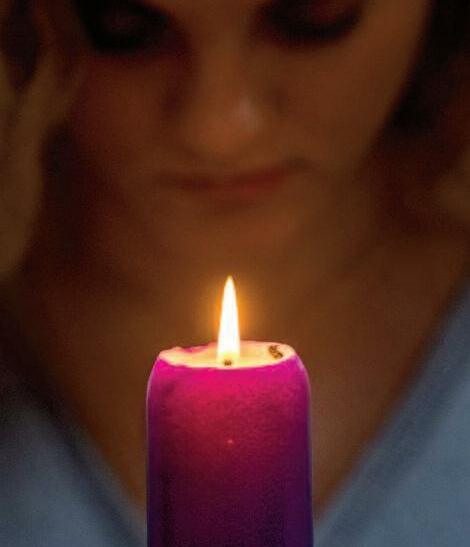
God of power and mercy, open our hearts in welcome. Remove the things that hinder us from receiving Christ with joy, so that we may share in His wisdom. May we become one with Him when He comes in glory, for He lives and reigns with You and the Holy Spirit, one God, forever and ever. Amen
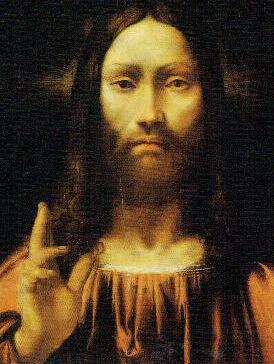
Do you have a favourite prayer? Please send to editor@scross.co.za


Merciful Father, hear our prayer and console us. As we renew our faith in Your S on, whom You raised from the dead, strengthen our hope that all our depar ted brothers and sisters will share in His resur rection. Eter nal rest g rant unto them O L ord, and let per petual light shine upon them. May they rest in peace. Amen
O J e s u s C h r i s t , I a c k n o w l e d g e y o u a s u n i v e r s a l K i n g . A l l t h a t h a s b e e n m a d e h a s b e e n c r e a t e d f o r Y o u . E x e r c i s e a l l Y o u r r i g h t s o v e r m e .





I r e n e w m y B a p t i s m a l V o w s I r e n o u n c e S a t a n , h i s g l a m o u r a n d h i s w o r k s ; I p r o m i s e t o l i v e a s a g o o d C h r i s t i a n A n d , i n p a r t i c u l a r d o I p l e d g e m y s e l f t o l a b o u r , t o t h e b e s t o f m y a b i l i t y , f o r t h e t r i u m p h o f t h e r i g h t s o f G o d a n d o f Y o u r C h u r c h . M a y Y o u r p e a c e b e e s t a b l i s h e d t h r o u g h o u t t h e w h o l e u n i v e r s e .



Unscramble the clues below to work out which SAINTS OF THE MONTH hide in these words

Sound sense for location of a church
What the women
morning (4,4)
on
Timed at the parish council
rings for
Praises for comical Santa (12)
21 Unable to receive
Word? (4,2,7)
Block progress among
Spinach Alice cooked for clerical
(5)
Compassion (8)
Medicine on a musical scale (5)
Lead or turn to painful experience (6)
Does he collect his books madly? (12)
The sacrament of reconciliation (7)
Could be the monster ’s headland (4)
Elijah’s fiery chariot may have penetrated it (12)
Communications (8)
Get soundly in colour, and did it again (7)
Pilate did it manually (6)
18 It may keep wedding cake cool (5)
along
It ’s used for frying with the note: sharp pain (4)
with
(hymn)
A S S Y R I A B A B Y L O N C A N A A N C Y P R U S E G Y P T
E T H I O P I A J U D A H LY D I A M A C E D O N I A M E L I TA
M E S O P O TA M I A P E R S I A P H I L I S T I A S A M A R I A S H E B A
O R D E R S P E A R M I N T N U N E V I C T E D P A L C H A O T I C L A S S A S S I S A I R S C O F F I N
T O E R O D E S U B U R B A N I T E S
B A P E T S T O N E S H I N E D K O Z A K A T H E G U F P E N A D E R O J I C H A B E N I R L I A L R A B A S W A G
U T I P O
A
A W S E I H
C S I O E K N J P P II T U
, ,,
, ,
Find
S S S OW O UO T H E R R R ND C

Across
4 German anti Nazi bishop (3,5)
City of Notre Dame (5)

Mea (5)
Country of Pope Francis (9)

Country of Card Jean Zerbo (4)
Italian town of St Anthony (5)
Pope Francis’ encyclical (7,2)
Rosary collecting soccer superstar (8,7)
Number of Apostles (6)
Brought Mary & Joseph to Bethlehem (6)
Fifth book of OT (11)
Site of Moses’ death (5,4)
Prophecy met (9)
1 Who was the first Catholic actor to play James Bond? a) Daniel Craig b) Pierce Brosnan c) Sean Conner y
2. Who is the cur rent president of the Souther n African Catholic Bishops’ Conference (SACBC)? a) Archbishop Buti Tlhagale b) Archbishop Dabula Mpako c) Bishop Sithembele Sipuka
3 What nationality was Adrian VI, the last non Italian pope before John Paul II, elected in 1522? a) Dutch b) English c) German
4 In Genesis 25, what kind of stew did Esau sell his bir thright for? a) Lamb b) Leek c) Lentil
5. Who is the patron saint of politicians?
27 Ecclesiastical building (6)
Clerical hat (7)
1. Church’s legal code (5,3)

First black SA bishop (surname) (7)

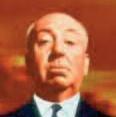
Raised from the dead by St Peter (7)
SACBC headquarters (6,5)
6 Thrilling Catholic film director (6,9)
7 Eastern Cape diocese (10)
OT Prophet (6)
Soweto church (6,5)
10 Vesting room (8)
11 St Joseph’s House or Cape bishop (5)
13. Saint of Tours (6)
17 Meaning of Catholic (9)
November 2 feast (3,5)
20 Cardinal McCann’s first name (4)
Part of priest ’s vestments (5)
Catholic raised singer Jennifer (5)
Mary ’s father (7)
Spiritual writer Fr Henri (6)
a) Robert Bellarmine b) King Louis IX c) Thomas More
6. What was the name of the alter native weekly newspaper founded by the SACBC in 1986?
a) New Era b) New Nation c) South
7 How many popes are listed as having reigned in the 1st centur y? a) 5 b) 10 c) 15
8 Which religious order for men is abbreviated CSsR?
a) Carmelites b) Redemptorists c) Stigmatines
9 To which musical was Pope Paul VI said to be par ticularly par tial?


a) Godspell b) Jesus Christ Superstar c) The Sound Of Music
10 In which present day countr y was St Paul bor n? a) Greece b) Turkey c) Syria
11. Which NT book features the phrase “in the twinkling of an eye”? a) 1 Corinthians b) Galatians c) Romans
12 According to the Vatican’s Latin dictionar y, what does juvenes voluptarii mean?
a) Beauty Queens b) Nudist Colonies c) Playboys
We welcome your letters, while reserving the right to edit them
We may publish your letters on our website Please include a postal address (not for publication) Letters should be no longer than 350 words. Pseudonyms are acceptable only under special circumstances at the Editor’s discretion Send your letters to editor@scross.co.za
Opinions expressed in The Southern Cross, especially in Letters to the Editor, do not necessarily reflect the views of the publication or those of the Catholic hierarchy
M O S T C AT H O L I C S K N O W A N D a c c e p t t h a t o t h e r f a i t h s w i l l always have a misconception and misunderstanding of our Catholic faith and doctrine. The fact that Raymond Perrier (“How other faiths see us”, August 2022) is in a position to engage other faith groups and poten tially correct misconceptions, if the situa tion allows for it is to be welcomed
W h e n i t c o m e s t o r e c e i v i n g t h e H o l y E u c h a r i s t a t M a s s , i n c l u d i n g R e q u i e m s , C a t h o l i c s h a v e t o c o n f o r m t o o u r C a t h o l i c s t a t u t e s T h e R e q u i e m M a s s i s n o t m e a n t t o a l l o w f o r e x e m p t i o n s t o s a t i s f y t h o s e w h o f e e l t h a t t h e y a r e n o t u n i t e d i n g r i e f i f t h e y c a n n o t r e c e i v e H o l y C o m m u n i o n
A p r i e s t o n c e n o t i c e d a r e g u l a r d a i l y a t t e n d e e a t M a s s a n d a s k e d h i m w h y h e w a s n o t r e c e i v i n g C o m m u n i o n T h e m a n a n s w e r e d t h a t h e w a s n o t a C a t h o l i c T h e p r i e s t a s k e d h i m w h e t h e r h e b e l i e v e d t h a t a f t e r t h e c o n s e c r a t i o n t h e b r e a d a n d w i n e b e c a m e t h e B o d y a n d B l o o d o f C h r i s t T h e m a n a f f i r m e d t h a t h e t r u l y b e l i e v e d t h i s . A f t e r t h a t t h e p r i e s t d i d n o t h e s i t a t e i n a l l o w i n g t h a t m a n t o r e c e i v e t h e H o l y E u c h a r i s t
I w o u l d r e g a r d i t a s s t r a n g e t o g i v e n o n C a t h o l i c s , u n d e r a n y c i rc u m s t a n c e s , t h e o p p o r t u n i t y t o r e c e i v e t h e H o l y E u c h a r i s t i f t h e y d o n o t k n o w a n d s h a r e t h e s e b e l i e f s .
S u r e l y t h e E u c h a r i s t i s t h e e s s e n c e o f o u r f a i t h A t t h e b e g i n n i n g o f o u r p a r i s h ’s E u c h a r i s t i c s e r v i c e , a w e l c o m e i s e x t e n d e d t o a l l o f t h o s e w h o a r e n o t a b l e t o r e c e i v e H o l y C o m m u n i o n , w i t h a n i n v i t a t i o n t o j o i n t h e C o m m u n i o n p r o c e s s i o n . Wi t h t h e i r a r m s a c r o s s t h e i r c h e s t s , t h e y t h e n r e c e i v e a b l e s s i n g
Bernard Moat, St Helena Bay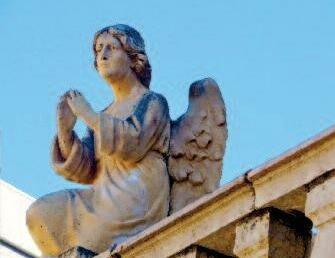
THANK YOU FOR AN OUTSTANDING p u b l i c a t i o n ; I c h e r i s h m y m o n t h l y c o p y o f T h e S o u t h e r n C r o s s I r e a d w i t h i n t e r e s t F r R o n R o l h e i s e r ’s a r t i c l e “ D o w e h a v e g u a r d i a n a n g e l s ? ” ( S e p t e m b e r 2 0 2 2 ) . B e i n g e s p e c i a l l y c l o s e t o m i n e , I f e e l c o m p e l l e d t o s a y t h a t g u a r d i a n a n g e l s a r e n o t , a s F r R o l h e i s e r p u t s i t , “ s i m p l y a n o t h e r w o r d f o r G o d ’s p r e s e n c e ” S t P a d r e P i o w a s e s p e c i a l l y c l o s e t o h i s g u a r d i a n a n g e l , a n d t h e r e i s a v o l u m e o f i n f o r m a t i o n a v a i l a b l e a b o u t t h i s ( s e e , f o r e x a m p l e , w w w y o u t u b e / h h n F 1 Z y Y Y S A )
A s a n a d u l t , I f i n d S t P a d r e P i o ’s p r a y e r t o g u a r d i a n a n g e l s a p p l i c a b l e : “ H o l y A n g e l o f t h e L o r d , m y z e a l o u s k e e p e r, e n t r u s t e d t o m e w i t h d i v i n e p i e t y, a l w a y s g u i d e m e , g u a r d m e , r u l e m e a n d i l l u m i n a t e m e A m e n ”
Sue Viljoen, Cape Townc o m m e n t e d o n m y l e t t e r i n y o u r
J u l y i s s u e , i n w h i c h I p r o p o s e d t h a t s i n c e t h e M a s s i s f o r m a n y C a t h o l i c s t h e o n l y c o n t a c t w i t h t h e i r f a i t h , i t s h o u l d , a r o u n d i t s s a c r e d c o r e , b e p r e s e n t e d i n t h e m o s t i n f o r m a t i v e , i n s t r u c t i v e , a p p e a l i n g , n o f r i l l s , n o n r o t e m a n n e r.
S o m e m i s s e d m y p o i n t a n d a v e r r e d t h a t t h e M a s s , a s h a n d e d d o w n f o r 2 0 0 0 y e a r s , s h o u l d n o t b e c h a n g e d I f e a r t h e y d i d n o t u n d e r s t a n d m y c r i d e c o e u r
P l e a s e p e r m i t m e a p a r a b l e w h i c h I d r a w f r o m m y p r e v i o u s l i f e a s a t e a c h e r
I n a u n i v e r s i t y d e p a r t m e n t t a s k e d w i t h t h e t e a c h i n g o f , s a y, b o t a n y, t h e r e a r e t w o p r o f e s s o r s E v e r y y e a r, o n e o f t h e m e n t e r s t h e l e c t u r e r o o m i n h i s b l a c k g r a d u a t e g o w n , a n d w i t h a v e r y s e r i o u s m i e n t a k e s u p h i s p o s i t i o n b e h i n d t h e l e c t e r n A f t e r s h a k i n g t h e d u s t o f f h i s l e c t u r e n o t e s , h e p r e c i s e l y d i c t a t e s t h e m a t e r i a l p a s s e d d o w n t o h i m f o r c e n t u r i e s b y h i s p r o f e s s o r i a l p r e d e c e s s o r s F r o w n i n g s e v e r e l y, h e q u a s h e s a n y o n e w h o d a r e s t o i n t e r r u p t h i m .
T h e o t h e r p r o f e s s o r e n t e r s t h e l e c t u r e r o o m n a t t i l y d r e s s e d , p e rc h e s h i m s e l f o n a c o r n e r o f a d e s k , w h i p s o u t h i s t a b l e t , a n d c o n j u r e s u p e x c i t i n g u p t o d a t e i n f o , a m a z i n g l y a n i m a t e d l i f e c y c l e s , m a g n i f i c e n t p h o t o g r a p h s a n d s t u n n i n g v i d e o c l i p s . A n d w h i l e h e s i t s t h e r e c o v e r i n g t h e s y l l a b u s , h e s p a r k s s p o n t a n e o u s d i s c o u r s e w i t h h i s s t u d e n t s .
W h i c h o f t h e s e t w o p r o f e s s o r s h a s t h e m o s t b e n e f i c i a l a n d e n d u r i n g e f f e c t o n t h e s t u d e n t s ’ u n d e r s t a n d i n g o f , a n d e x c i t e m e n t f o r, t h e s u b j e c t ?
I n t h e 1 9 6 0 s , t h e C h u rc h m a d e a n e n o r m o u s l e a p f r o m L a t i n t o t h e v e r n a c u l a r. T h e c h a n g e w a s b i t t e r l y o p p o s e d b y m a n y, b u t t h e C h u rc h c a n a n d d i d c h a n g e ! I t i s r e q u i r e d o f t h e C h u rc h t o d a y, e q u a l l y c o u r a g e o u s l y, t o t a k e t h e n e x t l o g i c a l s t e p : o p t i m a l l y p r e s e n t t h e o n e h o u r a w e e k t o t h e b e l i e v e r i n a s i n f o r m a t i v e , i n s t r u c t i v e , a p p e a l i n g , n o n r o t e , n o f r i l l s , a n d r e l e v a n t m a n n e r a s p o s s i b l e , a n d t h u s p r e s e n t a M a s s b e a u t i f u l l y a n d p o w e r f u l l y c r a f t e d a r o u n d i t s m o s t h o l y c o r e .
Frits Rijkenberg, HowickSouthernCrossword: ACROSS: 1 Site, 3 Tomb open, 9 Minuted, 10 Bands, 11 Acclamations, 13 Hard of, 15 Impede, 17 Chaplaincies, 20 Adage, 21 Hearing, 22 God sends, 23 Ages DOWN: 1 Sympathy, 2 Tonic, 4 Ordeal, 5 Bibliomaniac, 6 Penance, 7 Ness, 8 Stratosphere, 12 Mes sages, 14 Reheard, 16 Washed, 18 Icing, 19 Pang
Anagram Challenge: 1 Martin de Porres, 2 Vincent de Paul, 3 Scholastica, 4 Fran cis of Assisi, 5 Bernadette Soubirous

Dropped Letters: Augustine of Hippo, [Bl] Benedict Daswa Josephine Bakhita Perpetua Charles Lwanga Kiz ito [Bl] Isidore Bakanja
Quick Crossword: ACROSS: 4 Von Galen, 8 Paris, 9 Culpa, 12 Argentina, 14 Mali, 15 Padua, 16 Laudato Si, 18 Cristiano Ronaldo, 19 Twelve, 22 Census, 24 Deuteronomy, 25 Mount Nebo, 26 Fulfilled, 27 Church, 28 Biretta DOWN: 1 Canon Law, 2 Dlamini, 3 Tabitha, 5 Khanya House, 6 Alfred Hitchcock, 7 Queenstown, 8 Elijah, 9 Regina Mundi, 10 Sacristy, 11 David, 13 Martin, 17 Universal, 19 All Souls, 20 Owen, 21 Stole, 22 Lopez, 23 Joachim, 26 Nouwen
Catholic Trivia Quiz: 1 b) Pierce Brosnan, 2 c) Bishop Sithembele Sipuka, 3 a) Dutch, 4 c) Lentil (The mess of pottage in Gen 25:29 34), 5 c) St Thomas More, 6 b) New Nation, 7 a) Five, 8 b) Redemptorists, 9 b) Jesus Christ Superstar (Pope Paul especially liked the song “I Don’t Know How To Love Him”), 10 b) Turkey, 11 a) I Corinthians (15:52), 12 c) Playboys





‘Be praised, my Lord, through our sister bodily death, from whose em brace no living person can escape’ St Francis of Assisi (c 1181 1226)
‘The fundamental Christian conviction is that, far from separating us from the love of God, death marks the point at which temporal obstacles to our experience of that love pass away ’ Amy Plantinga Pauw (written in 1996)
‘Remembering the dead, caring for their tombs, and prayers of suffrage are testimony to confident hope, rooted in the certainty that death does not have the last word on human destiny, as humanity is destined for a life without end, that has its root and its fulfilment in God ’ Pope Francis (b.1936)
‘Nothing can make up for the absence of someone whom we love, and it would be wrong to try to find a substitute; we must simply hold out and see it through. That sounds very hard at first, but at the same time it is a great consolation, for the gap, as long as it remains unfilled, preserves the bond between us.’
Rev Dietrich Bonhoeffer (1906 45)
‘The reality is that you will grieve forever. You will not “get over” the loss of a loved one; you will learn to live with it. You will heal and you will rebuild yourself around the loss you have suffered You will be whole again, but you will never be the same Nor should you be the same, nor would you want to.’
Dr Elisabeth Kübler Ross (1926 2004)
‘For since we believe that Jesus died and was raised to life again, we also believe that when Jesus returns, God will bring back with him the believers who have died ’

1 Thessalonians 4:14
U




A snapshot from
e d a m i d a r m e d p o l i c e m e n d u r i n g a p r o t e s t i n t h i s s t i l l f r o m t h e d o c u m e n t a r y f i l m R e v o l u t i o n o f t h e H e a r t : T h e D o r o t h y D a y S t o r y T h e f o u n d e r o f t h e C a t h o l i c W o r k e r m o v e m e n t w a s b o r n 1 2 5 y e a r s a g o , o n N o v e m b e r 8 , 1 8 9 7 , i n C h i c a g o , I l l i n o i s , a n d d i e d o n N o v e m b e r 2 9 , 1 9 8 0 , i n N e w Y o r k C i t y
past,
exclusively for The Southern Cross
A s a y o u n g s e c u l a r j o u r n a l i s t , D a y w a s a r a d i c a l s o c i a l i s t w h o d r e w h e r i m p u l s e f o r s o c i a l j u s t i c e f r o m S c r i p t u r e A f t e r h e r c o n v e r s i o n t o C a t h o l i c i s m i n 1 9 2 7 , s h e m a i n t a i n e d h e r r a d i c a l s t r e a k , c o f o u n d i n g t h e C a t h o l i c W o r k e r n e w s p a p e r , w h i c h i s s t i l l r u n n i n g , w i t h P e t e r M a u r i n i n 1 9 3 3 O u t o f t h i s g r e w t h e C a t h o l i c W o r k e r m o v e m e n t , w h i c h h a s p r o v i d e d s h e l t e r , f o o d a n d c l o t h i n g t o t h e p o o r , a n d l a t e r d e v e l o p e d a s e r i e s o f f a r m s f o r c o m m u n a l l i v i n g i n t h e U S , C a n a d a a n d B r i t a i n . I n t h e 1 9 6 0 s a n d ‘ 7 0 s , D a y w a s a n a n t i w a r a c t i v i s t a n d p r o l i f i c w r i t e r , a l s o c o n d e m n i n g a p a r t h e i d i n S o u t h A f r i c a P o p e s B e n e d i c t X V I a n d F r a n c i s h a v e s t a t e d t h e i r a d m i r a t i o n f o r D a y , a n d h e r s a i n t h o o d c a u s e i s p r o c e e d i n g S h e p r o b a b l y w o u l d h a v e r e s e r v a t i o n s a b o u t t h a t S h e o n c e s a i d : “ D o n ’ t c a l l m e a s a i n t , I d o n ’ t w a n t t o b e d i s m i s s e d t h a t e a s i l y ” T h i s l i n e e x p r e s s e s D a y ’ s w e l l f o u n d e d f e a r t h a t h e r r a d i c a l a c t i v i s m m i g h t b e w h i t e w a s h e d a n d e v e n d i s t o r t e d (Original photo: Journey Films)
Agirl from a good Portuguese home has fallen in love with a boy who has only one shortcoming: he is a Protestant
One day, the mother takes her daugh ter aside: “Listen, your friend is a really nice guy, but if he wants to marry you, he has to become Catholic So what you do is this: When you go for a walk to gether, you tell him a lot about our
Church: about the pope, our many saints, the Mass, the Real Presence ”

The daughter promises to do that on their next date
The next evening she comes home in tears “What happened?” mother asks “Doesn’t he want to become a Catholic?”

Sobs the girl: “It’s much worse, Mother now he wants to become a priest!”
For all your sand and stone requirements in piet retief, southern Mpumalanga
017 826 0054/5 cell: 082 904 7840 Email: sales@eskaycrushers.co.za
